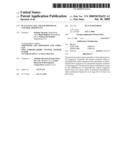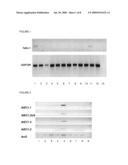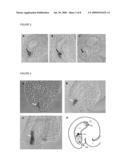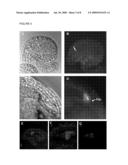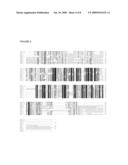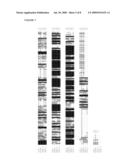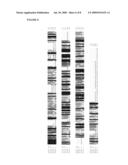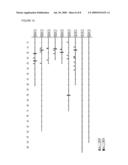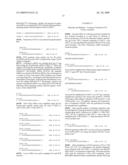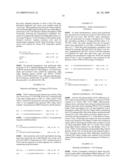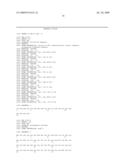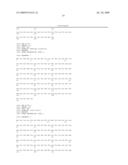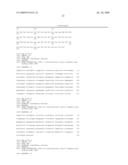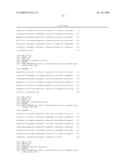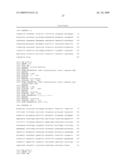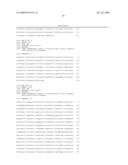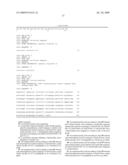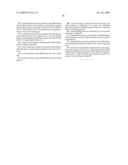Patent application title: PLANT EGG CELL TRANSCRIPTIONAL CONTROL SEQUENCES
Inventors:
Stefanie Sprunck (Regensburg, DE)
Birgit Bellman (Regensburg, DE)
Thomas Dresselhaus (Regensburg, DE)
Assignees:
ADELAIDE RESEARCH & INNOVATION PTY LTD
GRAINS RESEARCH & DEVELOPMENT CORPORATION
IPC8 Class: AC12N510FI
USPC Class:
435419
Class name: Chemistry: molecular biology and microbiology plant cell or cell line, per se (e.g., transgenic, mutant, etc.); composition thereof; process of propagating, maintaining, or preserving plant cell or cell line; process of isolating or separating a plant cell or cell line; process of regenerating plant cells into tissue, plant part, or plant, per se, where no genotypic change occurs; medium therefore plant cell or cell line, per se, contains exogenous or foreign nucleic acid
Publication date: 2009-07-30
Patent application number: 20090191635
Claims:
1-54. (canceled)
55. An isolated nucleic acid comprising:(i) a nucleotide sequence defining a plant female gamete-specific transcriptional control sequence, wherein said transcriptional control sequence is derived from a gene which encodes an EC 1 polypeptide which comprises the amino acid sequence set forth in (SEQ ID NOS:1, 70 and 71); or(ii) a nucleotide sequence defining a functionally active fragment or variant of (i).
56. An isolated nucleic acid according to claim 55 wherein said transcriptional control sequence is derived from a gene which encodes an EC1 polypeptide in an Arabidopsis sp. plant.
57. An isolated nucleic acid according to claim 55 wherein said transcriptional control sequence is derived from a gene which encodes an EC1 polypeptide in an Arabidopsis sp. plant.
58. An isolated nucleic acid according to claim 55 wherein said isolated nucleic acid comprises a nucleotide sequence selected from the list consisting of: SEQ ID NO: 24, SEQ ID NO: 25, SEQ ID NO: 26, SEQ ID NO: 27, SEQ ID NO: 28 or a functionally active fragment or variant of any of the foregoing.
59. An isolated nucleic acid according to claim 55 wherein said transcriptional control sequence is derived from a gene which encodes an EC1 polypeptide in a Medicago sp. plant.
60. An isolated nucleic acid according to claim 55 wherein said isolated nucleic acid comprises the nucleotide sequence set forth in SEQ ID NO: 29, or a functionally active fragment or variant thereof.
61. An isolated nucleic acid according to claim 55 wherein said transcriptional control sequence is derived from a gene which encodes an EC1 polypeptide in an Oryza sp. plant.
62. An isolated nucleic acid according to claim 55 wherein said isolated nucleic acid comprises a nucleotide sequence selected from the list consisting of: SEQ ID NO: 30, SEQ ID NO: 31, SEQ ID NO: 32 or a functionally active fragment or variant of any of the foregoing.
63. An isolated nucleic acid according to claim 55 wherein said isolated nucleic acid comprises one or more sequence motifs comprising the nucleotide sequence set forth in SEQ ID NO: 33 and/or SEQ ID NO: 69.
64. A nucleic acid construct comprising an isolated nucleic acid according to claim 55.
65. A cell comprising a nucleic acid construct according to claim 64; and/or a genomically integrated form of said construct.
66. A cell according to claim 65 wherein the cell is a plant cell.
67. A cell according to claim 66 wherein the cell is a plant egg cell.
68. A cell according to claim 67 wherein the level, rate and/or pattern of expression of at least one nucleotide sequence is altered in said plant egg cell relative to a wild type form of said plant egg cell.
69. A multicellular structure comprising one or more cells according to claim 65.
70. A multicellular structure according to claim 69 wherein the multicellular structure comprises a plant or a part, organ or tissue thereof.
71. A multicellular structure according to claim 70 wherein said multicellular structure comprises one or more plant egg cells.
72. A method for specifically or preferentially expressing a nucleotide sequence of interest in a plant egg cell, the method comprising effecting transcription of the nucleotide sequence of interest in a plant under the transcriptional control of a nucleic acid according to claim 55.
Description:
FIELD OF THE INVENTION
[0001]The present invention relates generally to transcriptional control sequences. Generally, the present invention relates to transcriptional control sequences that specifically or preferentially direct expression of a nucleotide sequence of interest in a plant egg cell.
BACKGROUND OF THE INVENTION
[0002]The primary emphasis in genetic modification has been directed to prokaryotes and mammalian cells. For a variety of reasons, plants have proven more intransigent than other eukaryotic cells to genetically manipulate. However, in many instances, it is desirable to effect transcription of an introduced nucleotide sequence of interest either specifically or preferentially in a particular plant part or at a particular developmental stage of the plant. Accordingly, there is substantial interest in identifying transcriptional control sequences, such as promoters or enhancers, which specifically or preferentially direct transcription in particular plant organs, tissues or cell types or at particular developmental stages of the plant.
[0003]Expression of heterologous DNA sequences in a plant is dependent upon the presence of an operably linked transcriptional control sequence, such as a promoter or enhancer, which is functional within the plant. The choice of transcriptional control sequence will determine when and where within the organism the heterologous DNA sequence is expressed. For example, where continuous expression is desired throughout the cells of a plant, constitutive promoters are utilized. In contrast, where gene expression in response to a stimulus is desired, an inducible promoter may be used. Where expression in specific tissues or organs is desired, a tissue-specific promoter may be used.
[0004]Frequently, it is desirable to effect expression of a DNA sequence in particular cells, tissues or organs of a plant. For example, male and/or female sterility in a plant might be accomplished by genetic manipulation of the plant's genome with a male or female gamete specific promoter operably linked to a toxic protein.
[0005]Alternatively, it might be desirable to inhibit expression of a native DNA sequence within particular plant tissues to achieve a desired phenotype. In this case, such inhibition might be accomplished by transformation of the plant with a tissue-specific promoter operably linked to an antisense or RNAi nucleotide sequence, such that expression of these sequences produces an RNA transcript that interferes with translation of the mRNA of the native DNA sequence.
[0006]Promoter sequences that can be used to drive egg cell specific expression of a nucleotide sequence of interest in higher plants are not presently available. This may be at least in part attributed to the difficulty in isolating female gametes from seed plants. As a consequence of this difficulty, the transcripts of plant egg cells are poorly represented in current databases of expressed sequence tags (ESTs), which have been mainly generated through sequencing from cDNA libraries produced from complex tissues, e.g. whole floral organs. Though more than 1.5 million Poaceae ESTs were present in the public EST database (by March 2004) the use of complex tissues resulted in under representation of genes expressed at low levels and in only one or a few cell types.
[0007]However, the isolation and characterization of egg cell-specific transcriptional control sequences would be desirable for use in the genetic manipulation of plants.
[0008]Reference to any prior art in this specification is not, and should not be taken as, an acknowledgment or any form of suggestion that this prior art forms part of the common general knowledge in any country.
SUMMARY OF THE INVENTION
[0009]The present invention is predicated, in part, on the identification of transcriptional control sequences derived from EC1 genes which, in preferred embodiments, direct preferential expression in an egg cell of at least one plant taxon.
[0010]Accordingly, in a first aspect, the present invention provides an isolated nucleic acid comprising: [0011](i) a nucleotide sequence defining a transcriptional control sequence, wherein said transcriptional control sequence is derived from a gene which encodes an EC1 polypeptide; or [0012](ii) a nucleotide sequence defining a functionally active fragment or variant of (i).
[0013]In accordance with the present invention, a consensus sequence for EC1 polypeptides has been determined. Accordingly, in one particularly preferred embodiment, the isolated nucleic acid of the first aspect of the invention comprises a transcriptional control sequence derived from a gene which encodes a polypeptide comprising the amino acid sequence:
TABLE-US-00001 [XN] CWXXXXX [LI] X [SH] C [TS] X [DE] [IL] [ILV] XFF [LIV] [XN] [LI] (SEQ ID NO: 1) XXXCCX [AS] [ILV] XXXXXXCW [XN] [ILV] G [FL] TXXEXXXLXXXC [XN]
[0014]wherein x is any amino acid residue; [XN] is one or more amino acid residues of any type; [LI] or [IL] is a leucine or isoleucine residue; [SH] is a serine or histidine residue; [TS] is a threonine or serine residue; [DE] is an aspartic acid or glutamic acid residue; [ILV] or [LIV] is a leucine, isoleucine or valine residue; [AS] is an alanine or serine residue; and [FL] is a phenylalanine or leucine residue.
[0015]In further preferred embodiments the isolated nucleic acid comprises one or more sequence motifs comprising the nucleotide sequence set forth in SEQ ID NO: 33 and/or SEQ ID NO: 69.
[0016]In a preferred form, the transcriptional control sequences of the present invention, or functionally active fragments or variants thereof, are plant egg cell specific or plant egg cell preferential transcriptional control sequences.
[0017]In a second aspect, the present invention provides an isolated nucleic acid selected from the list consisting of: [0018](i) a nucleic acid comprising the nucleotide sequence set forth in any of SEQ ID NO: 24, SEQ ID NO: 25, SEQ ID NO: 26, SEQ ID NO: 27, SEQ ID NO: 28, SEQ ID NO: 29, SEQ ID NO: 30, SEQ ID NO: 31 and SEQ ID NO: 32; [0019](ii) a nucleic acid comprising a nucleotide sequence which is at least 50% identical to any of the nucleotide sequences mentioned in (i); [0020](iii) a nucleic acid which hybridizes to any of the nucleic acids mentioned in (i) under stringent conditions; [0021](iv) a nucleic acid comprising a nucleotide sequence which is the complement or reverse complement of any one of (i) to (iii); and [0022](v) a fragment of any of (i), (ii), (iii) or (iv).
[0023]In a third aspect, the present invention provides a nucleic acid construct comprising the isolated nucleic acid of the first and/or second aspects of the invention.
[0024]In a preferred embodiment, the isolated nucleic acid comprises a nucleotide sequence defining a transcriptional control sequence and further comprises a nucleotide sequence of interest operably connected to the transcriptional control sequence. More preferably, the nucleotide sequence of interest is heterologous with respect to said transcriptional control sequence.
[0025]In a fourth aspect, the present invention provides a cell comprising: [0026](i) the nucleic acid construct of the third aspect of the invention; and/or [0027](ii) a genomically integrated form of the construct mentioned at (i).
[0028]In a particularly preferred embodiment, the cell is a plant egg cell. Even more preferably, the level, rate and/or pattern of expression of at least one nucleotide sequence is altered in said plant egg cell relative to a wild type form of said plant egg cell.
[0029]In a fifth aspect, the present invention provides a multicellular structure comprising one or more cells of the fourth aspect of the invention. Preferably, the multicellular structure comprises a plant or a part, organ or tissue thereof.
[0030]In a sixth aspect, the present invention provides a method for specifically or preferentially expressing a nucleotide sequence of interest in a plant egg cell, the method comprising effecting transcription of the nucleotide sequence of interest in a plant under the transcriptional control of the nucleic acid of any of the first, second, or third aspects of the invention, wherein said nucleic acid comprises a plant egg cell specific or plant egg cell preferential transcriptional control sequence.
[0031]In a seventh aspect, the present invention provides a method for promoting female sterility in a plant, the method comprising expressing a nucleotide sequence encoding a cytotoxic or cytostatic protein or a cytotoxic of cytostatic non-translated RNA, specifically or preferentially in an egg cell of the plant; wherein said nucleotide sequence is operably connected to a nucleic acid of any of the first, second or third aspects of the invention and wherein said nucleic acid comprises a plant egg cell specific or plant egg cell preferential transcriptional control sequence.
[0032]In an eighth aspect, the present invention provides a method for modulating embryo development and/or embryo size in a plant, the method comprising expressing a nucleotide sequence encoding a transcriptional regulator that acts during embryo development, specifically or preferentially in an egg cell of the plant; wherein said nucleotide sequence encoding a transcriptional regulator is operably connected to a nucleic acid of any of the first, second or third aspects of the invention and wherein said nucleic acid comprises a plant egg cell specific or plant egg cell preferential transcriptional control sequence.
[0033]In a ninth aspect, the present invention provides a method for promoting apomixis in a plant, the method comprising expressing an apomixis-promoting nucleotide sequence specifically or preferentially in an egg cell of the plant; wherein said apomixis-promoting nucleotide sequence is operably connected to a nucleic acid of any of the first, second or third aspects of the invention and wherein said nucleic acid comprises a plant egg cell specific or plant egg cell preferential transcriptional control sequence.
[0034]Throughout this specification, unless the context requires otherwise, the word "comprise", or variations such as "comprises" or "comprising", will be understood to imply the inclusion of a stated element or integer or group of elements or integers but not the exclusion of any other element or integer or group of elements or integers.
[0035]Nucleotide and amino acid sequences are referred to herein by a sequence identifier number (SEQ ID NO:). A summary of the sequence identifiers is provided in Table 1. A sequence listing is provided at the end of the specification.
TABLE-US-00002 TABLE 1 Summary of Sequence Identifiers Sequence Identifier in Identifier Sequence sequence listing SEQ ID NO: 1 EC1 polypeptide consensus amino acid sequence N/A SEQ ID NO: 2 AtEC1.1 polypeptide amino acid sequence <400> 1 SEQ ID NO: 3 AtEC1.2a polypeptide amino acid sequence <400> 2 SEQ ID NO: 4 AtEC1.2b polypeptide amino acid sequence <400> 3 SEQ ID NO: 5 AtEC1.4 polypeptide amino acid sequence <400> 4 SEQ ID NO: 6 AtEC1.5 polypeptide amino acid sequence <400> 5 SEQ ID NO: 7 MtEC1.1 polypeptide amino acid sequence <400> 6 SEQ ID NO: 8 OsEC1.1 polypeptide amino acid sequence <400> 7 SEQ ID NO: 9 OsEC1.2 polypeptide amino acid sequence <400> 8 SEQ ID NO: 10 OsEC1.3 polypeptide amino acid sequence <400> 9 SEQ ID NO: 11 TaEC1 polypeptide amino acid sequence <400> 10 SEQ ID NO: 12 HvECA1 polypeptide amino acid sequence <400> 11 SEQ ID NO: 13 AtEC1.1 open reading frame nucleotide sequence <400> 12 SEQ ID NO: 14 AtEC1.2a open reading frame nucleotide sequence <400> 13 SEQ ID NO: 15 AtEC1.2b open reading frame nucleotide sequence <400> 14 SEQ ID NO: 16 AtEC1.4 open reading frame nucleotide sequence <400> 15 SEQ ID NO: 17 AtEC1.5 open reading frame nucleotide sequence <400> 16 SEQ ID NO: 18 MtEC1.1 open reading frame nucleotide sequence <400> 17 SEQ ID NO: 19 OsEC1.1 open reading frame nucleotide sequence <400> 18 SEQ ID NO: 20 OsEC1.2 open reading frame nucleotide sequence <400> 19 SEQ ID NO: 21 OsEC1.3 open reading frame nucleotide sequence <400> 20 SEQ ID NO: 22 TaEC1 cDNA nucleotide sequence <400> 21 SEQ ID NO: 23 HvECA1 open reading frame nucleotide sequence <400> 22 SEQ ID NO: 24 pAtEC1.1 nucleotide sequence <400> 23 SEQ ID NO: 25 pAtEC1.2a nucleotide sequence <400> 24 SEQ ID NO: 26 pAtEC1.2b nucleotide sequence <400> 25 SEQ ID NO: 27 pAtEC1.4 nucleotide sequence <400> 26 SEQ ID NO: 28 pAtEC1.5 nucleotide sequence <400> 27 SEQ ID NO: 29 pMtEC1.1 nucleotide sequence <400> 28 SEQ ID NO: 30 pOsEC1.1 nucleotide sequence <400> 29 SEQ ID NO: 31 pOsEC1.2 nucleotide sequence <400> 30 SEQ ID NO: 32 pOsEC1.3 nucleotide sequence <400> 31 SEQ ID NO: 33 EC1 promoter nucleotide sequence motif #1 <400> 32 SEQ ID NO: 34 TaGAP1 primer <400> 33 SEQ ID NO: 35 TaGAP2 primer <400> 34 SEQ ID NO: 36 TaEC1fw2 primer <400> 35 SEQ ID NO: 37 TaEC1rev2 primer <400> 36 SEQ ID NO: 38 Act3fw primer <400> 37 SEQ ID NO: 39 Act3rev primer <400> 38 SEQ ID NO: 40 AtEC1.1fw primer <400> 39 SEQ ID NO: 41 AtEC1.1rev primer <400> 40 SEQ ID NO: 42 AtEC1.2a/bfw primer <400> 41 SEQ ID NO: 43 AtEC1.2a/brev primer <400> 42 SEQ ID NO: 44 AtEC1.4fw primer <400> 43 SEQ ID NO: 45 AtEC1.4rev primer <400> 44 SEQ ID NO: 46 AtEC1.5fw primer <400> 45 SEQ ID NO: 47 AtEC1.5rev primer <400> 46 SEQ ID NO: 48 pAtEC1.1 primer <400> 47 SEQ ID NO: 49 AtEC1.1rev1 primer <400> 48 SEQ ID NO: 50 pAtEC1.2a primer <400> 49 SEQ ID NO: 51 tAtEC1.2a primer <400> 50 SEQ ID NO: 52 AtEC1.1-PstI primer <400> 51 SEQ ID NO: 53 AtEC1.2a-BgIII primer <400> 52 SEQ ID NO: 54 GUS start rev primer <400> 53 SEQ ID NO: 55 E1F primer <400> 54 SEQ ID NO: 56 E1R primer <400> 55 SEQ ID NO: 57 EC1-PF2 primer <400> 56 SEQ ID NO: 58 EC1-R primer <400> 57 SEQ ID NO: 59 GFP-seq primer <400> 58 SEQ ID NO: 60 LH1 primer <400> 59 SEQ ID NO: 61 GUS3 primer <400> 60 SEQ ID NO: 62 GUS4 primer <400> 61 SEQ ID NO: 63 bar-fw primer <400> 62 SEQ ID NO: 64 bar-rev primer <400> 63 SEQ ID NO: 65 1-1fwXbaI primer <400> 64 SEQ ID NO: 66 1-1revXbaI primer <400> 65 SEQ ID NO: 67 At2a-BgIIIfw primer <400> 66 SEQ ID NO: 68 At2a-SaIrev primer <400> 67 SEQ ID NO: 69 EC1 promoter nucleotide sequence motif #2 <400> 68
DESCRIPTION OF PREFERRED EMBODIMENTS
[0036]It is to be understood that the following description is for the purpose of describing particular embodiments only and is not intended to be limiting with respect to the above description.
[0037]As set out above, the present invention is predicated, in part, on the identification of transcriptional control sequences which are derived from EC1 genes that are preferentially expressed in the egg cells of at least some plants.
[0038]As used herein, the term "transcriptional control sequence" should be understood as any nucleotide sequence that modulates at least the transcription of an operably connected nucleotide sequence. Furthermore, the transcriptional control sequence of the present invention may comprise any one or more of, for example, a leader, promoter, enhancer or upstream activating sequence.
[0039]As referred to herein, the term "transcriptional control sequence" preferably at least includes a promoter.
[0040]A "promoter" as referred to herein, encompasses any nucleic acid that confers, activates or enhances expression of an operably connected nucleotide sequence in a cell.
[0041]As used herein, the term "operably connected" refers to the connection of a transcriptional control sequence, such as a promoter, and a nucleotide sequence of interest in such as way as to bring the nucleotide sequence of interest under the transcriptional control of the transcriptional control sequence. For example, promoters are generally positioned 5' (upstream) of a nucleotide sequence to be operably connected to the promoter. In the construction of heterologous transcriptional control sequence/nucleotide sequence of interest combinations, it is generally preferred to position the promoter at a distance from the transcription start site that is approximately the same as the distance between that promoter and the gene it controls in its natural setting, i.e. the gene from which the promoter is derived. As is known in the art, some variation in this distance can be accommodated without loss of promoter function.
[0042]Accordingly, in a first aspect, the present invention provides an isolated nucleic acid comprising: [0043](i) a nucleotide sequence defining a transcriptional control sequence, wherein said transcriptional control sequence is derived from a gene which encodes an EC1 polypeptide; or [0044](ii) a nucleotide sequence defining a functionally active fragment or variant of (i).
[0045]In the present invention, "isolated" refers to material removed from its original environment (eg., the natural environment if it is naturally occurring), and thus is altered "by the hand of man" from its natural state. For example, an isolated polynucleotide could be part of a vector or a composition of matter, or could be contained within a cell, and still be isolated because that vector, composition of matter, or particular cell is not the original environment of the polynucleotide. An "isolated" nucleic acid molecule should also be understood to include a synthetic nucleic acid molecule, including those produced by chemical synthesis using known methods in the art or by in-vitro amplification (eg. polymerase chain reaction and the like).
[0046]The isolated nucleic acid of the present invention may comprise any polyribonucleotide or polydeoxyribonucleotide, which may be unmodified RNA or DNA or modified RNA or DNA. For example, the isolated nucleic acids of the invention may comprise single- and double-stranded DNA, DNA that is a mixture of single- and double-stranded regions, single- and double-stranded RNA, and RNA that is mixture of single- and double-stranded regions, hybrid molecules comprising DNA and RNA that may be single-stranded or, more typically, double-stranded or a mixture of single- and double-stranded regions. In addition, the isolated nucleic acids may comprise triple-stranded regions comprising RNA or DNA or both RNA and DNA. The isolated nucleic acid molecules may also contain one or more modified bases or DNA or RNA backbones modified for stability or for other reasons. "Modified" bases include, for example, tritylated bases and unusual bases such as inosine. A variety of modifications can be made to DNA and RNA; thus, "polynucleotide" embraces chemically, enzymatically, or metabolically modified forms.
[0047]As set out above, the present invention contemplates, among other things, a nucleotide sequence defining a transcriptional control sequence, wherein said transcriptional control sequence is derived from a gene which encodes an EC1 polypeptide. As referred to herein, an "EC1 polypeptide" refers to a polypeptide which is substantially specifically expressed in an egg cell of a plant. Generally, EC1 polypeptides are small (generally less than about 200 amino acid residues) and are putatively secreted. In some embodiments, the EC1 polypeptides contemplated herein further comprise about six conserved cysteine residues and may further comprise a signal peptide for extracellular localization.
[0048]The nucleic acids of the present invention comprise nucleotide sequence defining which is "derived from a gene which encodes an EC1 polypeptide". The term "derived from", as it is used herein, refers to a source or origin for the transcriptional control sequence. As such, a transcriptional control sequence "derived from a gene which encodes an EC1 polypeptide" refers to a transcriptional control sequence which, in its native state, exerts at least some transcriptional control over a gene which encodes an EC1 polypeptide in an organism, preferably a plant.
[0049]In accordance with the present invention, a consensus EC1 polypeptide sequence has been determined. Accordingly, in one particularly preferred embodiment, the isolated nucleic acid of the first aspect of the invention comprises a transcriptional control sequence derived from a gene which encodes a polypeptide comprising the amino acid sequence:
TABLE-US-00003 [XN]CWXXXXX[LI]X[SH]C[TS]X[DE][IL][ILV]XFF[LIV][XN][LI] (SEQ ID NO:1) XXXCCX[AS][ILV]XXXXXXCW[XN][ILV]G[FL]TXXEXXXLXXXC[XN]
[0050]wherein X is any amino acid residue; [XN] is one or more amino acid residues of any type; [LI] or [IL] is a leucine or isoleucine residue; [SH] is a serine or histidine residue; [TS] is a threonine or serine residue; [DE] is an aspartic acid or glutamic acid residue; [ILV] or [LIV] is a leucine, isoleucine or valine residue; [AS] is an alanine or serine residue; and [FL] is a phenylalanine or leucine residue.
[0051]Accordingly, in one embodiment, the present invention provides an isolated nucleic acid comprising: [0052](i) a nucleotide sequence defining a transcriptional control sequence, wherein said transcriptional control sequence is derived from a gene which encodes a polypeptide comprising the amino acid sequence set forth in SEQ ID NO: 1; or [0053](ii) a functionally active fragment or variant of (i).
[0054]In further embodiments, the transcriptional control sequence is derived from a gene which encodes a polypeptide comprising the amino acid sequence set forth in any of SEQ ID NO: 2, SEQ ID NO: 3, SEQ ID NO: 4, SEQ ID NO: 5, SEQ ID NO: 6, SEQ ID NO: 7, SEQ ID NO: 8, SEQ ID NO: 9, SEQ ID NO: 10 and SEQ ID NO: 11.
[0055]In yet further embodiments, the transcriptional control sequence is derived from a gene which comprises an open reading frame comprising the nucleotide sequence set forth in any of SEQ ID NO: 13, SEQ ID NO: 14, SEQ ID NO: 15, SEQ ID NO: 16, SEQ ID NO: 17, SEQ ID NO: 18, SEQ ID NO: 19, SEQ ID NO: 20, SEQ ID NO: 21, SEQ ID NO: 22 and SEQ ID NO: 23.
[0056]In specific embodiments, the present invention provides an isolated nucleic comprising a nucleotide sequence defining a transcriptional control sequence, wherein the transcriptional control sequence comprises the nucleotide sequence set forth in any one of SEQ ID NO: 24, SEQ ID NO: 25, SEQ ID NO: 26, SEQ ID NO: 27, SEQ ID NO: 28, SEQ ID NO: 29, SEQ ID NO: 30, SEQ ID NO: 31, SEQ ID NO: 32, or a functionally active fragment or variant thereof.
[0057]In yet further embodiments the isolated nucleic acid comprises one or more sequence motifs comprising the nucleotide sequence set forth in SEQ ID NO: 33 and/or SEQ ID NO: 69.
[0058]As set out above, the present invention also provides a nucleic acid comprising a nucleotide sequence defining a functionally active fragment or variant of the subject transcriptional control sequences.
[0059]As referred to herein, a "functionally active fragment or variant" refers to a fragment or variant which retains the functional activity of a transcriptional control sequence.
[0060]"Functionally active fragments", as contemplated herein, may be of any length wherein the transcriptional control sequence retains the capability to affect expression of an operably connected nucleotide sequence. The fragment may comprise, for example, at least 50 nucleotides (nt), at least 100 nt or at least 200 nt. For example, in specific embodiments, a fragment at least 50 nt in length comprises fragments which include 50 or more contiguous bases from, for example, the nucleotide sequence of any of SEQ ID NO: 24, SEQ ID NO: 25, SEQ ID NO: 26, SEQ ID NO: 27, SEQ ID NO: 28, SEQ ID NO: 29, SEQ ID NO: 30, SEQ ID NO: 31, SEQ ID NO: 32.
[0061]"Functionally active variants" of the transcriptional control sequence of the invention include orthologs, mutants, synthetic variants, analogs and the like which retain the capability to affect expression of an operably connected nucleotide sequence. For example, the term "variant" should be considered to specifically include, for example, orthologous transcriptional control sequences from other organisms; mutants of the transcriptional control sequence; variants of the transcriptional control sequence wherein one or more of the nucleotides within the sequence has been substituted, added or deleted; and analogs that contain one or more modified bases or DNA or RNA backbones modified for stability or for other reasons. "Modified" bases include, for example, tritylated bases and unusual bases such as inosine.
[0062]In some embodiments, the functionally active fragment or variant comprises may comprise, for example, at least 50% sequence identity, at least 65% sequence identity, at least 80% sequence identity or at least 95% sequence identity to the nucleotide sequence set forth in any of SEQ ID NO: 24, SEQ ID NO: 25, SEQ ID NO: 26, SEQ ID NO: 27, SEQ ID NO: 28, SEQ ID NO: 29, SEQ ID NO: 30, SEQ ID NO: 31, SEQ ID NO: 32.
[0063]When comparing nucleotide sequences to calculate a percentage identity, the compared nucleotide sequences should be compared over a comparison window of at least 50 nucleotide residues, at least 100 nucleotide residues, at least 200 nucleotide residues, at least 500 nucleotide residues or over the full length of any of SEQ ID NO: 24, SEQ ID NO: 25, SEQ ID NO: 26, SEQ ID NO: 27, SEQ ID NO: 28, SEQ ID NO: 29, SEQ ID NO: 30, SEQ ID NO: 31, SEQ ID NO: 32. The comparison window may comprise additions or deletions (i.e. gaps) of about 20% or less as compared to the reference sequence (which does not comprise additions or deletions) for optimal alignment of the two sequences. Optimal alignment of sequences for aligning a comparison window may be conducted by computerized implementations of algorithms such the BLAST family of programs as, for example, disclosed by Altschul et al. (Nucl. Acids Res. 25: 3389-3402, 1997). A detailed discussion of sequence analysis can be found in Unit 19.3 of Ausubel et al. ("Current Protocols in Molecular Biology" John Wiley & Sons Inc, 1994-1998, Chapter 15, 1998).
[0064]In some specific embodiments, the transcriptional control sequences provided by the present invention, or functionally active fragments or variants thereof, comprise plant egg cell specific or plant egg cell preferential transcriptional control sequences.
[0065]As used herein, a "plant egg cell specific" transcriptional control sequence refers to a transcriptional control sequence which directs the expression of an operably connected nucleotide sequence of interest substantially only in an egg cell of a plant. A "plant egg cell preferential" transcriptional control sequence refers to a transcriptional control sequence which directs the expression of an operably connected nucleotide sequence at a higher level in a plant egg cell than in one or more other tissues of the plant, eg. leaf tissue or root tissue. Generally, preferential expression in an egg cell includes expression of a nucleotide sequence of interest in a plant egg cell at a level of at least twice, at least 5 times or at least 10 times the level of expression seen in at least one other tissue of a plant, eg. leaf or root tissue.
[0066]As referred to herein, the term "plant egg cell" should be understood to include a cell which is a component of the female gametophyte in a plant. For example, in angiosperm plants, the term "plant egg cell" may include a female gamete, a synergid, a central cell or an antipodal cell of the female gametophyte (embryo sac). In one specific embodiment, the term "plant egg cell" should be understood to refer to a female gamete of a plant.
[0067]In a second aspect, the present invention provides an isolated nucleic acid selected from the list consisting of: [0068](i) a nucleic acid comprising the nucleotide sequence set forth in any of SEQ ID NO: 24, SEQ ID NO: 25, SEQ ID NO: 26, SEQ ID NO: 27, SEQ ID NO: 28, SEQ ID NO: 29, SEQ ID NO: 30, SEQ ID NO: 31 and SEQ ID NO: 32; [0069](ii) a nucleic acid comprising a nucleotide sequence which is at least 50% identical to any of the nucleotide sequences mentioned in (i); [0070](iii) a nucleic acid which hybridizes to any of the nucleic acids mentioned in (i) under stringent conditions; [0071](iv) a nucleic acid comprising a nucleotide sequence which is the complement or reverse complement of any one of (i) to (iii); and [0072](v) a fragment of any of (i), (ii), (iii) or (iv).
[0073]In one embodiment, the isolated nucleic acid defined at (ii) comprises at least 50% sequence identity, at least 65% sequence identity, at least 80% sequence identity or at least 95% sequence identity to the nucleotide sequence set forth in any of SEQ ID NO: 24, SEQ ID NO: 25, SEQ ID NO: 26, SEQ ID NO: 27, SEQ ID NO: 28, SEQ ID NO: 29, SEQ ID NO: 30, SEQ ID NO: 31, SEQ ID NO: 32.
[0074]In another embodiment, the isolated nucleic acid of the second aspect of the invention comprises a nucleotide sequence which defines a transcriptional control sequence or a complement, reverse complement or fragment thereof. In yet another embodiment, the isolated nucleic acid of the second aspect of the invention comprises a nucleotide sequence which defines an egg cell specific or egg cell preferential transcriptional control sequence or a complement, reverse complement or fragment thereof.
[0075]As set out at (iii) above, the second aspect of the invention provides isolated nucleic acids which hybridize to any of the nucleic acids mentioned at (i). As used herein, "stringent" hybridisation conditions will be those in which the salt concentration is less than about 1.5 M Na ion, typically about 0.01 to 1.0 M Na ion concentration (or other salts) at pH 7.0 to 8.3 and the temperature is at least 30° C. Stringent conditions may also be achieved with the addition of destabilizing agents such as formamide. Stringent hybridisation conditions may be low stringency conditions, medium stringency conditions or high stringency conditions. Exemplary low stringency conditions include hybridisation with a buffer solution of 30 to 35% formamide, 1 M NaCl, 1% SDS (sodium dodecyl sulphate) at 37° C., and a wash in 1× to 2×SSC (20×SSC=3.0 M NaCl/0.3 M trisodium citrate) at 50 to 55° C. Exemplary moderate stringency conditions include hybridisation in 40 to 45% formamide, 1.0 M NaCl, 1% SDS at 37° C., and a wash in 0.5× to 1×SSC at 55 to 60° C. Exemplary high stringency conditions include hybridisation in 50% formamide, 1 M NaCl, 1% SDS at 37° C., and a wash in 0.1×SSC at 60 to 65° C. Optionally, wash buffers may comprise about 0.1% to about 1% SDS. Duration of hybridization is generally less than about 24 hours, usually about 4 to about 12 hours.
[0076]Specificity of hybridisation is also affected by post-hybridization washes, with influencing parameters including the ionic strength and temperature of the final wash solution. For DNA-DNA hybrids, the Tm can be approximated from the equation of Meinkoth and Wahl (Anal. Biochem. 138: 267-284, 1984), i.e. Tm=81.5° C.+16.6 (log M)+0.41 (% GC)-0.61 (% form)-500/L; where M is the molarity of monovalent cations, % GC is the percentage of guanosine and cytosine nucleotides in the DNA, % form is the percentage of formamide in the hybridization solution, and L is the length of the hybrid in base pairs. The Tm is the temperature (under defined ionic strength and pH) at which 50% of a complementary target sequence hybridizes to a perfectly matched probe. Tm is reduced by about 1° C. for each 1% of mismatching; thus, Tm, hybridization, and/or wash conditions can be adjusted to hybridize to sequences of different degrees of complementarity. For example, sequences with ≧90% identity can be hybridised by decreasing the Tm by about 10° C. Generally, stringent conditions are selected to be about 5° C. lower than the thermal melting point (Tm) for the specific sequence and its complement at a defined ionic strength and pH. However, high stringency conditions can utilize a hybridization and/or wash at, for example, 1, 2, 3, or 4° C. lower than the thermal melting point (Tm); medium stringency conditions can utilize a hybridization and/or wash at, for example, 6, 7, 8, 9, or 10° C. lower than the thermal melting point (Tm); low stringency conditions can utilize a hybridization and/or wash at, for example, 11, 12, 13, 14, 15, or 20° C. lower than the thermal melting point (Tm). Using the equation, hybridization and wash compositions, and desired Tm, those of ordinary skill will understand that variations in the stringency of hybridization and/or wash solutions are inherently described. If the desired degree of mismatching results in a Tm of less than 45° C. (aqueous solution) or 32° C. (formamide solution), it is preferred to increase the SSC concentration so that a higher temperature can be used. An extensive guide to the hybridization of nucleic acids is found in Tijssen (Laboratory Techniques in Biochemistry and Molecular Biology-Hybridization with Nucleic Acid Probes, Pt I, Chapter 2, Elsevier, New York, 1993), Ausubel et al., eds. (Current Protocols in Molecular Biology, Chapter 2, Greene Publishing and Wiley-Interscience, New York, 1995) and Sambrook et al. (Molecular Cloning: A Laboratory Manual, 2nd ed., Cold Spring Harbor Laboratory Press, Plainview, N.Y., 1989).
[0077]As set out above, the second aspect of the present invention also contemplates nucleic acid fragments.
[0078]"Fragments" of a nucleotide sequence may be, for example, at least 5 nucleotides (nt), at least 10 nt, at least 20 nt, at least 50, at least 100, at least 150, at least 200, at least 250, at least 300, at least 350, at least 400, at least 450 or at least 500 nt in length. These fragments have numerous uses that would be evident to one of skill in the art and include, for example, diagnostic probes and primers. Of course, larger fragments, may also be useful, as are fragments corresponding to most, if not all, of the nucleotide sequences set forth in any of SEQ ID NO: 24, SEQ ID NO: 25, SEQ ID NO: 26, SEQ ID NO: 27, SEQ ID NO: 28, SEQ ID NO: 29, SEQ ID NO: 30, SEQ ID NO: 31 and SEQ ID NO: 32. For example, a fragment at least 5 nt in length may refer to a fragment which includes 5 or more contiguous bases from, for example, the nucleotide sequence of any of SEQ ID NO: 24, SEQ ID NO: 25, SEQ ID NO: 26, SEQ ID NO: 27, SEQ ID NO: 28, SEQ ID NO: 29, SEQ ID NO: 30, SEQ ID NO: 31 and SEQ ID NO: 32.
[0079]The isolated nucleic acids (or fragments or variants thereof) of the present invention may be derived from any source. For example, the nucleic acids may be derived from an organism, such as a plant. Suitable plants include, for example, monocotyledonous angiosperms (monocots), dicotyledonous angiosperms (dicots), gymnosperms and the like.
[0080]Exemplary dicots include, for example, Arabidopsis spp., Medicago spp., Nicotiana spp., soybean, canola, oil seed rape, sugar beet, mustard, sunflower, potato, safflower, cassaya, yams, sweet potato, other Brassicaceae such as Thellungiella halophila, among others.
[0081]In one embodiment, the isolated nucleic acids of the present invention may comprise a transcriptional control sequence derived from a gene which encodes an EC1 polypeptide in an Arabidopsis sp. plant. For example the transcriptional control sequences defined herein as pAtEC1.1 (SEQ ID NO: 24), pAtEC1.2a (SEQ ID NO: 25), pAtEC1.2b (SEQ ID NO: 26), pAtEC1.4 (SEQ ID NO: 27) and pAtEC1.5 (SEQ ID NO: 28) are derivable from genes comprising the AtEC1.1 (SEQ ID NO: 13), AtEC1.2a (SEQ ID NO: 14), AtEC1.2b (SEQ ID NO: 15), AtEC1.4 (SEQ ID NO: 16) and AtEC1.5 (SEQ ID NO: 17) open reading frame nucleotide sequences, respectively, from Arabidopsis thaliana.
[0082]In another embodiment, the isolated nucleic acid of the present invention may comprise a transcriptional control sequence derived from a gene which encodes an EC1 polypeptide in a Medicago sp. plant. For example the transcriptional control sequence defined herein as pMtEC1 (SEQ ID NO: 29) is derivable from a gene comprising the MtEC1.1 (SEQ ID NO: 18) open reading frame nucleotide sequence from Medicago truncatula.
[0083]In further preferred embodiments, the plant is a monocot, more preferably a cereal crop plant.
[0084]As used herein, the term "cereal crop plant" includes members of the order Poales, and more preferably the family Poaceae, which produce edible grain for human or animal food. Examples of cereal crop plants that in no way limit the present invention include barley, wheat, rice, maize, millets, sorghum, rye, triticale, oats, teff, rice, spelt and the like. However, the term cereal crop plant should also be understood to include a number of non-Poales species that also produce edible grain, which are known as pseudocereals, and include, for example, amaranth, buckwheat and quinoa.
[0085]In one embodiment, the isolated nucleic acid of the present invention may comprise a transcriptional control sequence derived from a gene which encodes an EC1 polypeptide in an Oryza sp. plant. For example the transcriptional control sequences defined herein as pOsEC1.1 (SEQ ID NO: 30), pOsEC1.2 (SEQ ID NO: 31) and pOsEC1.3 (SEQ ID NO: 32), are derivable from genes comprising the OsEC1.1 (SEQ ID NO: 19), OsEC1.2 (SEQ ID NO: 20) and OsEC1.2b (SEQ ID NO: 21) open reading frame nucleotide sequences, respectively, from Oryza sativa.
[0086]In further embodiments, the present invention also contemplates synthetic nucleic acids.
[0087]In a third aspect, the present invention provides a nucleic acid construct comprising the isolated nucleic acid of the first and/or second aspects of the invention.
[0088]The nucleic acid construct of the present invention may comprise any polyribonucleotide or polydeoxyribonucleotide, which may be unmodified RNA or DNA or modified RNA or DNA. For example, the nucleic acid construct of the invention may comprise single- and/or double-stranded DNA, DNA that is a mixture of single- and double-stranded regions, single- and double-stranded RNA, and RNA that is mixture of single- and double-stranded regions, hybrid molecules comprising DNA and RNA that may be single-stranded or, more typically, double-stranded or a mixture of single- and double-stranded regions. In addition, the nucleic acid construct may comprise triple-stranded regions comprising RNA or DNA or both RNA and DNA. The nucleic acid construct may also comprise one or more modified bases or DNA or RNA backbones modified for stability or for other reasons. "Modified" bases include, for example, tritylated bases and unusual bases such as inosine. A variety of modifications can be made to DNA and RNA; thus the term "nucleic acid construct" embraces chemically, enzymatically, or metabolically modified forms.
[0089]In one embodiment, the nucleic acid construct comprises DNA. Accordingly, the nucleic acid construct of the present invention may comprise, for example, a linear DNA molecule, a plasmid, a transposon, a cosmid, an artificial chromosome and the like. Furthermore, the nucleic acid construct of the present invention may be a separate nucleic acid molecule or may be a part of a larger nucleic acid molecule.
[0090]In another embodiment, the isolated nucleic acid comprises a nucleotide sequence defining a transcriptional control sequence and further comprises a nucleotide sequence of interest operably connected to the transcriptional control sequence.
[0091]In some embodiments, the nucleotide sequence of interest is heterologous with respect to the transcriptional control sequence.
[0092]As used herein, the term "heterologous with respect to the transcriptional control sequence" refers to the nucleotide sequence of interest being a nucleotide sequence other than that which the transcriptional control sequence is operably connected to in its natural state.
[0093]For example, in its natural state, pAtEC1.1 (SEQ ID NO: 24) is operably connected to a gene comprising the AtEC1.1 open reading frame (SEQ ID NO: 13). Accordingly, in this example, any nucleotide sequence other than a nucleotide sequence comprising an open reading frame consisting of the nucleotide sequence set forth in SEQ ID NO: 13 should be considered heterologous with respect to SEQ ID NO: 24. Similarly, any nucleotide sequence other than a nucleotide sequence comprising an open reading frame consisting of the nucleotide sequence set forth in SEQ ID NO: 14 should be considered heterologous with respect to SEQ ID NO: 25; any nucleotide sequence other than a nucleotide sequence comprising an open reading frame consisting of the nucleotide sequence set forth in SEQ ID NO: 15 should be considered heterologous with respect to SEQ ID NO: 26; any nucleotide sequence other than a nucleotide sequence comprising an open reading frame consisting of the nucleotide sequence set forth in SEQ ID NO: 16 should be considered heterologous with respect to SEQ ID NO: 27; any nucleotide sequence other than a nucleotide sequence comprising an open reading frame consisting of the nucleotide sequence set forth in SEQ ID NO: 17 should be considered heterologous with respect to SEQ ID NO: 28; any nucleotide sequence other than a nucleotide sequence comprising an open reading frame consisting of the nucleotide sequence set forth in SEQ ID NO: 18 should be considered heterologous with respect to SEQ ID NO: 29; any nucleotide sequence other than a nucleotide sequence comprising an open reading frame consisting of the nucleotide sequence set forth in SEQ ID NO: 19 should be considered heterologous with respect to SEQ ID NO: 30; any nucleotide sequence other than a nucleotide sequence comprising an open reading frame consisting of the nucleotide sequence set forth in SEQ ID NO: 20 should be considered heterologous with respect to SEQ ID NO: 31; and any nucleotide sequence other than a nucleotide sequence comprising an open reading frame consisting of the nucleotide sequence set forth in SEQ ID NO: 21 should be considered heterologous with respect to SEQ ID NO: 32.
[0094]Accordingly, a sequence that is heterologous with respect to a particular transcriptional control sequence may therefore include, for example, orthologous EC1 sequences, reporter genes, selectable marker genes, heterologous protein-encoding nucleic acid sequences; heterologous non-translated RNA encoding nucleic acid sequences and the like.
[0095]In a further embodiment, the nucleic acid construct may further comprise a nucleotide sequence defining a transcription terminator.
[0096]The term "transcription terminator" or "terminator" refers to a DNA sequence at the end of a transcriptional unit which signals termination of transcription. Terminators are 3'-non-translated DNA sequences generally containing a polyadenylation signal, which facilitates the addition of polyadenylate sequences to the 3'-end of a primary transcript. As with promoter sequences, the terminator may be any terminator sequence which is operable in the cells, tissues or organs in which it is intended to be used. Examples of suitable terminator sequences which may be useful in plant cells include: the nopaline synthase (nos) terminator, the CaMV 35S terminator, the octopine synthase (ocs) terminator, potato proteinase inhibitor gene (pin) terminators, such as the pinII and pinIII terminators and the like.
[0097]In one specific embodiment, the nucleic acid construct of the third aspect of the invention comprises an expression cassette comprising the structure:
[N]w-TCS-[N]x-Sol-[N]y-TT-[N]z)
wherein:[N]w comprises one or more nucleotide residues, or is absent;TCS comprises the nucleic acid of the first and/or second aspects of the invention, wherein the nucleic acid defines a transcriptional control sequence;[N]x comprises one or more nucleotide residues, or is absent;Sol comprises a nucleotide sequence of interest which encodes an mRNA or non-translated RNA, wherein the nucleotide sequence, Sol, is operably connected to TCS;[N]y comprises one or more nucleotide residues, or is absent;TT comprises a nucleotide sequence defining a transcription terminator;[N]z comprises one or more nucleotide residues, or is absent.
[0098]The nucleic acid constructs of the present invention may further comprise nucleotide sequences such as, an origin of replication for one or more hosts; a selectable marker gene which is active in one or more hosts and the like.
[0099]As used herein, the term "selectable marker gene" includes any gene that confers a phenotype on a cell, in which it is expressed, to facilitate the identification and/or selection of cells which are transfected or transformed with a genetic construct of the invention.
[0100]"Selectable marker genes" include any nucleotide sequences which, when expressed by a cell, confer a phenotype on the cell that facilitates the identification and/or selection of transformed cells. A range of nucleotide sequences encoding suitable selectable markers are known in the art. Exemplary nucleotide sequences that encode selectable markers include: antibiotic resistance genes such as ampicillin-resistance genes, tetracycline-resistance genes, kanamycin-resistance genes, the AURI-C gene which confers resistance to the antibiotic aureobasidin A, neomycin phosphotransferase genes (eg. nptI and nptII) and hygromycin phosphotransferase genes (eg. hpt); herbicide resistance genes including glufosinate, phosphinothricin or bialaphos resistance genes such as phosphinothricin acetyl transferase encoding genes (eg. bar, glyphosate resistance genes including 3-enoyl pyruvyl shikimate 5-phosphate synthase encoding genes (eg. aroA), bromyxnil resistance genes including bromyxnil nitrilase encoding genes, sulfonamide resistance genes including dihydropterate synthase encoding genes (eg. sul) and sulfonylurea resistance genes including acetolactate synthase encoding genes; enzyme-encoding reporter genes such as GUS and chloramphenicol acetyltransferase (CAT) encoding genes; fluorescent reporter genes such as the green fluorescent protein-encoding gene; and luminescence-based reporter genes such as the luciferase gene, amongst others.
[0101]The genetic constructs of the present invention may include further nucleotide sequences intended for the maintenance and/or replication of the genetic construct in prokaryotes or eukaryotes and/or the integration of the genetic construct or a part thereof into the genome of a eukaryotic or prokaryotic cell.
[0102]In one embodiment, the construct of the invention is adapted to be at least partially transferred into a plant cell via Agrobacterium-mediated transformation. Accordingly, in a further embodiment, the nucleic acid construct of the present invention comprises left and/or right T-DNA border sequences.
[0103]Suitable T-DNA border sequences would be readily ascertained by one of skill in the art. However, the term "T-DNA border sequences" should be understood to encompass any substantially homologous and substantially directly repeated nucleotide sequences that delimit a nucleic acid molecule that is transferred from an Agrobacterium sp. cell into a plant cell susceptible to Agrobacterium-mediated transformation. By way of example, reference is made to the paper of Peralta and Ream (Proc. Natl. Acad. Sci. USA, 82(15): 5112-5116, 1985) and the review of Gelvin (Microbiology and Molecular Biology Reviews, 67(1): 16-37, 2003).
[0104]The present invention also contemplates any suitable modifications to the genetic construct which facilitate bacterial mediated insertion into a plant cell via bacteria other than Agrobacterium sp., for example, as described in Broothaerts et al. (Nature 433: 629-633, 2005).
[0105]Those skilled in the art will be aware of how to produce the constructs described herein and of the requirements for obtaining the expression thereof, when so desired, in a specific cell or cell-type under the conditions desired. In particular, it will be known to those skilled in the art that the genetic manipulations required to perform the present invention may require the propagation of a genetic construct described herein or a derivative thereof in a prokaryotic cell such as an E. coli cell or a plant cell or an animal cell. Exemplary methods for cloning nucleic acid molecules are described in Sambrook et al. (Molecular Cloning: A Laboratory Manual, Cold Spring Harbor Laboratory Press, New York, 2000).
[0106]In a fourth aspect, the present invention provides a cell comprising: [0107](i) the nucleic acid construct of the third aspect of the invention; and/or [0108](ii) a genomically integrated form of the construct mentioned at (i).
[0109]The nucleic acid construct may be maintained in the cell as a nucleic acid molecule, as an autonomously replicating genetic element (eg. a plasmid, cosmid, artificial chromosome or the like) or it may be integrated into the genomic DNA of the cell.
[0110]As used herein, the term "genomic DNA" should be understood in its broadest context to include any and all DNA that makes up the genetic complement of a cell. As such, the genomic DNA of a cell should be understood to include chromosomes, mitochondrial DNA, plastid DNA, chloroplast DNA, endogenous plasmid DNA and the like. As such, the term "genomically integrated" contemplates chromosomal integration, mitochondrial DNA integration, plastid DNA integration, chloroplast DNA integration, endogenous plasmid integration, and the like.
[0111]The cells contemplated by the fourth aspect of the invention include any prokaryotic or eukaryotic cell.
[0112]In one embodiment, the cell is a plant cell. As used herein, the term "plant" includes any plant which comprises an egg cell, including, for example, dicotyledonous or monocotyledonous angiosperms and gymnosperms.
[0113]In another embodiment, the plant cell is a dicotyledonous plant cell, for example, an Arabidopsis sp. cell. In yet another embodiment the cell is a monocotyledonous plant cell and/or a cereal crop plant cell.
[0114]In one specific embodiment, the cell is a plant egg cell. In a further embodiment, the level, rate and/or pattern of expression of at least one nucleotide sequence is altered in the plant egg cell relative to a wild type form of said plant egg cell.
[0115]In yet another embodiment, the cell may also comprise a prokaryotic cell. For example the prokaryotic cell may include an Agrobacterium sp. cell which carries the nucleic acid construct and which may, for example, be used to transform a plant. In yet another embodiment, the prokaryotic cell may include an E. coli cell, which may, for example, be used in the construction or cloning of a nucleic acid construct.
[0116]In a fifth aspect, the present invention provides a multicellular structure comprising one or more cells of the fourth aspect of the invention.
[0117]In one embodiment, the multicellular structure comprises a plant or a part, organ or tissue thereof.
[0118]As referred to herein, "a plant or a part, organ or tissue thereof" should be understood to specifically include a whole plant; a plant tissue; a plant organ; a plant part; plant reproductive material (including, for example, cuttings, seed, flowers, pollen and the like); and cultured plant tissue such as a callus or suspension culture.
[0119]The multicellular structure may comprise one or more plant egg cells. For example, the multicellular structure may comprise a plant, a flower, a carpel or pistil, a plant ovary, an ovule or a female gametophyte (embryo sac). In one embodiment, the level, rate and/or pattern of expression of at least one nucleotide sequence is altered in said one or more plant egg cells of the multicellular structure relative to a wild type form of said egg cell.
[0120]As set out above, the present invention is predicated, in part, on effecting transcription of the nucleotide sequence of interest under the transcriptional control of the nucleic acid of the first, second or third aspects of the invention, wherein said nucleic acid comprises a transcriptional control sequence.
[0121]Accordingly, in a sixth aspect, the present invention provides a method for specifically or preferentially expressing a nucleotide sequence of interest in a plant egg cell, the method comprising effecting transcription of the nucleotide sequence of interest in a plant under the transcriptional control of the nucleic acid of any of the first, second or third aspects of the invention, wherein said nucleic acid comprises a plant egg cell specific or plant egg cell preferential transcriptional control sequence.
[0122]Generally, specific or preferential expression of a nucleotide sequence of interest is effected by introducing said nucleic acid into a plant cell such that the nucleotide sequence of interest is operably connected to a transcriptional control sequence of the present invention.
[0123]The present invention contemplates any method to effect operable connection of a nucleotide sequence of interest to the transcriptional control sequence of the invention. For example, a nucleotide sequence of interest may be incorporated into the nucleic acid molecule that comprises the transcriptional control sequence, and be operably connected thereto. In this way, the nucleotide sequence of interest and transcriptional control sequence are both introduced into the plant. Alternatively, the nucleic acid sequence of the present invention may be inserted into the plant genome such that it is placed in operable connection with an endogenous EC1 transcriptional control sequence. As would be recognised by one of skill in the art, the insertion of the transcriptional control sequence into the plant genome may be either by non-site specific insertion or by site-specific insertion (for an example of site-specific insertion see Terada et al., Nat Biotechnol 20: 1030-1034, 2002).
[0124]The nucleic acid may be introduced into a plant via any suitable method. For example, an explant or cultured plant tissue may be transformed with a nucleic acid molecule, and the transformed explant or cultured plant tissue subsequently regenerated into a mature plant which produces seed including the nucleic acid molecule; a nucleic acid may be directly transformed into a plant, either stably or transiently; a nucleic acid may be introduced into a plant via breeding using a parent plant that carries the nucleic acid molecule; and the like.
[0125]In one embodiment, the nucleic acid molecule is introduced into a plant cell via transformation. Plant cells may be transformed using any method known in the art that is appropriate for the particular plant species. Common methods include Agrobacterium-mediated transformation, microprojectile bombardment based transformation methods and direct DNA uptake based methods. Roa-Rodriguez et al. (Agrobacterium-mediated transformation of plants, 3rd Ed. CAMBIA Intellectual Property Resource, Canberra, Australia, 2003) review a wide array of suitable Agrobacterium-mediated plant transformation methods for a wide range of plant species. Microprojectile bombardment may also be used to transform plant tissue and methods for the transformation of plants, particularly cereal plants, and such methods are reviewed by Casas et al. (Plant Breeding Rev. 13: 235-264, 1995). Direct DNA uptake transformation protocols such as protoplast transformation and electroporation are described in detail in Galbraith et al. (eds.), Methods in Cell Biology Vol. 50, Academic Press, San Diego, 1995). In addition to the methods mentioned above, a range of other transformation protocols may also be used. These include infiltration, electroporation of cells and tissues, electroporation of embryos, microinjection, pollen-tube pathway, silicon carbide- and liposome mediated transformation. Methods such as these are reviewed by Rakoczy-Trojanowska (Cell. Mol. Biol. Lett. 7: 849-858, 2002). A range of other plant transformation methods may also be evident to those of skill in the art and, accordingly, the present invention should not be considered in any way limited to the particular plant transformation methods exemplified above.
[0126]The nucleotide sequence of interest, which is placed under the regulatory control of the transcriptional control sequence of the present invention, may include any nucleotide sequence of interest. General categories of nucleotide sequences of interest may include, for example: [0127](i) cytotoxin genes such as barnase, RNase or diphtheria toxin which may be used to induce female sterility and/or embryoless fruits in a plant; [0128](ii) genes encoding transcriptional regulators acting during later stages of embryo development such as BBM or LEC1/LEC2, AP2 transcription factors which may be used to modify embryo development and/or increase embryo size; [0129](iii) genes encoding cell cycle regulators such as RB or E2F, transcriptional regulators acting during later stages of embryo development such as BBM, LEC1/LEC2 or chromatin remodelling factors such as DNA methyltransferases, histone modifying enzymes and the like, which may be used to effect apomictic embryo development (eg. parthenogenesis; autonomous embryogenesis); [0130](iv) reporter genes, such as those encoding GUS, GFP and the like; [0131](v) genes involved in cellular metabolism such as Zinc finger proteins, kinases, heat shock proteins and the like; [0132](vi) genes involved in agronomic traits such as disease or pest resistance or herbicide resistance; [0133](vii) genes involved in grain characteristics such as grain biomass, nutritional value, post-harvest characteristics and the like; [0134](viii) genes encoding heterologous proteins, such as proteins encoding heterologous enzymes or structural proteins or proteins involved in biosynthetic pathways for heterologous products; [0135](ix) nucleotide sequences encoding non-translated RNA, for example an siRNA, miRNA, antisense RNA and the like.
[0136]Generally, the nucleotide sequence of interest is heterologous with respect to the transcriptional control sequence.
[0137]In a seventh aspect, the present invention provides a method for promoting female sterility in a plant, the method comprising expressing a nucleotide sequence encoding a cytotoxic or cytostatic protein or a cytotoxic of cytostatic non-translated RNA, specifically or preferentially in an egg cell of the plant; wherein said nucleotide sequence is operably connected to a nucleic acid of any of the first, second or third aspects of the invention and wherein said nucleic acid comprises a plant egg cell specific or plant egg cell preferential transcriptional control sequence.
[0138]As referred to herein, the "cytotoxic or cytostatic protein" or "cytotoxic or cytostatic non-translated RNA" refers to any protein or non-translated RNA that inhibits or prevents the growth, division, metabolic function or fertilisation of the egg cell. In some embodiments, the nucleotide sequence encodes a cytotoxic protein selected from the list consisting of a barnase, an RNAse or a diphtheria toxin.
[0139]In an eighth aspect, the present invention provides a method for modulating embryo development and/or embryo size in a plant, the method comprising expressing a nucleotide sequence encoding a transcriptional regulator that acts during embryo development, specifically or preferentially in an egg cell of the plant; wherein said nucleotide sequence encoding a transcriptional regulator is operably connected to a nucleic acid of any of the first, second or third aspects of the invention and wherein said nucleic acid comprises a plant egg cell specific or plant egg cell preferential transcriptional control sequence.
[0140]In one embodiment, the nucleotide sequence encoding a transcriptional regulator comprises a transcriptional regulator which acts during later stages of embryo development, more preferably the transcriptional regulator comprises a BBM, LEC1/LEC2, AP2 or other transcription factor.
[0141]In a ninth aspect, the present invention provides a method for promoting apomixis in a plant, the method comprising expressing an apomixis-promoting nucleotide sequence specifically or preferentially in an egg cell of the plant; wherein said apomixis-promoting nucleotide sequence is operably connected to a nucleic acid of the first second or third aspects of the invention and wherein said nucleic acid comprises a plant egg cell specific or plant egg cell preferential transcriptional control sequence.
[0142]As used herein, the term "apomixis-promoting nucleotide sequence" includes any nucleotide sequence which promotes apomixis when expressed in a plant, and, more particularly, when expressed in a plant egg cell. The apoxmis-promoting nucleotide sequence may include, for example, a nucleotide sequence which encodes any of: [0143](i) a cell cycle regulator, such as RB or E2F; [0144](ii) a transcriptional regulator that acts during later stages of embryo development, such as BBM, LEC1/LEC2; [0145](iii) a chromatin remodeling factor such as a DNA methyltransferase; or [0146](iv) a histone modifying enzyme.
[0147]The methods of the sixth, seventh, eighth and ninth aspects of the present invention may be performed using any suitable plant. However, in one preferred embodiment, the plant is a dicotyledonous plant and, in another embodiment, an Arabidopsis sp. plant. In further embodiments, the plant may be a monocotyledonous plant and/or a cereal crop plant.
[0148]Finally, reference is made to standard textbooks of molecular biology that contain methods for carrying out basic techniques encompassed by the present invention, including DNA restriction and ligation for the generation of the various genetic constructs described herein. See, for example, Maniatis et al., Molecular Cloning: A Laboratory Manual (Cold Spring Harbor Laboratory Press, New York, 1982) and Sambrook et al. (2000, supra).
[0149]The present invention is further described by the following non-limiting examples:
BRIEF DESCRIPTION OF THE FIGURES
[0150]FIG. 1 shows an expression profile of C06--3 transcripts (TaEC1) originally derived from the wheat egg cell cDNA library. Expression of TaEC1 was examined by RT-PCR using DNAse treated total RNA from different tissues of wheat and gene specific primers for C06--3. As controls, cDNA from egg cells, central cells and 2-celled pro-embryos have been used. Quality and quantity of generated cDNA was verified using primers for the ubiquitously expressed GAP-DH. Lane 1: egg cell, 2: pro-embryo, 3: central cell, 4: coleoptile, 5: primary leaf, 6: mature leaf, 7: stem, 8: root without tip, 9: root tip, 10: anther, 11: pistil, 12: kernel 12 dap (days after pollination), 13: negative control.
[0151]FIG. 2 shows an expression profile of AtEC1-like genes in Arabidopsis. Expression was examined by RT-PCR using DNAse treated mRNA from different tissues of Arabidopsis and gene specific primers for AtEC1.1, AtEC1.2a/b, AtEC1.4 and AtEC1.5. All five genes of Arabidopsis are exclusively expressed in tissues which contain the female gametophyte. Quality and quantity of generated cDNA was verified using primer for the ubiquitously expressed Actin 3 gene. Lane 1: leaf, 2: stem, 3: root, 4: flower bud, 5: mature flower, 6: flower 1-3 dap, 7: pistil, 8: anther, 9: negative control.
[0152]FIG. 3 shows transcript localisation of AtEC1-like genes in Arabidopsis ovules. In situ hybridization was performed using embedded sections of mature pistils hybridized with an AtEC1.2a antisense probe (A) and AtEC1.1 antisense probe (B). As control, sense probes of AtEC1.1 (C) and AtEC1.2a were used. Arrows point towards egg cell, showing egg cell specific signals in (A) and (B). Transcripts of AtEC1-like genes could not be detected in other cells of the unfertilized embryo sac or in young embryos, early after fertilization (not shown).
[0153]FIG. 4 shows promoter activity of AtEC1-like genes in Arabidopsis. Promoters pAtEc1.1 and pAtEc1.2 were cloned as translational fusions 5' upstream of the β-Glucuronidase gene. Cloned constructs were used for stable transformation of Arabidopsis. Arrows point at egg cells showing GUS staining in pAtEc1.1::GUS (A) and pAtEc1.2a::GUS ovules before fertilisation (B) and a zygote after fertilisation (C). GUS activity was only observed in egg cells of unfertilised ovules. After fertilisation, GUS activity was still visible in the zygote (C); however, this was due to the high stability of β-Glucuronidase. A schematic of an unfertilized Arabidopsis ovule is shown in (D) (Drews and Yadegari, Annu. Rev. Genet. 36: 99-124, 2002). Abbreviations: (ac) antipodal cells; (cc) central cell; (ch) chalaza; (ec) egg cell; (emb) embryo; (f) funiculus; (mp) micropyle; (sc) synergid; (sn) secondary nucleus; (zyg) zygote.
[0154]FIG. 5 shows the expression of EGFP (enhanced green fluorescent protein) as a C-terminal fusion to the open reading frame of AtEC1.1, under control of the promoter of pAtEC1.1. The construct was used for transformation of Arabidopsis thaliana. Ovules of transgenic plants were analyzed microscopically for green fluorescence using DIC (A, C) and UV-light (B, D) as well as UV-light for CLSM (confocal laser scanning microscopy) (E-G). Green fluorescence was visible at the chalazal pole of egg cells in unfertilized ovules (arrow in B) before fertilization. After fertilization, secreted fluorescent protein is visible between the zygote (zyg; arrow) and the neighbouring endosperm (C and D). CLSM shows the protein within vesicles of the unfertilized egg cell. (F) is an enlargement of (E) and (G) shows EGFP fluorescence of the egg cell. Red fluorescence was removed.
[0155]FIG. 6 shows an alignment of EC1 cDNA and predicted genomic sequences encoding open reading frames (ORFs) derived from wheat (TaEC1), barley (HvECA1), rice (OsEC1) and Arabidopsis (AtEC1).
[0156]FIG. 7 shows an alignment of EC1 ORFs derived from cereal cDNA and predicted genomic sequences.
[0157]FIG. 8 shows an alignment of EC1 predicted ORFs derived from Arabidopsis thaliana genomic sequences.
[0158]FIG. 9 shows a protein-alignment of EC1 proteins from wheat (TaEC1), barley (HvECA1), rice (OsEC1), Arabidopsis (AtEC1) and Medicago truncatula (MtEC1.1).
[0159]FIG. 10 is a graphical representation showing novel over-represented motifs in the upstream region of egg cell specific expressed genes identified by MotifSampler. The motif finding algorithm uses Gibbs sampling to find the position probability matrix that represents the motif.
EXAMPLE 1
Identification of Genes Specifically Expressed in Plant Egg Cells
[0160]To order to identify genes that are specifically expressed in the egg cell, female gametophytes of wheat were initially microdissected to isolate egg cells. Using the messenger RNA from 12 egg cells, a cDNA library was constructed and single-run partial sequencing of 960 randomly selected cDNA clones was performed. After DNA sequencer trace data passed an automated cleanup pipeline, a total of 735 ESTs were used for bioinformatical analysis. The 735 ESTs formed 404 independent clusters including 310 singletons.
[0161]The consensus sequences of the clusters were used for BLASTN and BLASTX searches at the NCBI nonredundant database (nr), dbEST and SwissProt database. Some cDNA sequences resulted in limited sequence information from non-coding regions. Therefore, searches were performed against the TIGR Wheat Gene Index Release 8.0, using the BLASTN algorithm. If a match with >95% sequence identity over the total length of the query sequence was found, the matching sequence was retrieved and used in subsequent BLASTX searches in place of the original EST. BLASTN searches against the NCBI database category of non-mouse and non-human ESTs resulted in 629 egg cell ESTs (333 clusters) matching significantly to annotated ESTs mainly generated from different vegetative tissues of wheat, barley or rice (NCBI dbEST Poaceae). 106 egg cell ESTs (71 clusters) did not match annotated ESTs and were thus considered as "novel" transcripts.
[0162]Transcripts were selected which did not match to any EST generated from vegetative plant tissues, and which matched to so-called "hypothetical" proteins (computer-predicted open reading frames from the Arabidopsis and/or rice genome sequences). It was assumed that the corresponding genes of some of these transcripts might be specifically expressed in egg cells of seed plants.
[0163]Significant similarities to "hypothetical" proteins of Arabidopsis and/or rice were identified for 98 egg cell clusters. Of these, 11 clusters were not similar to any published EST but only to annotated "hypothetical" genes detected in genomes of Arabidopsis and/or rice and it was concluded that these might be candidate genes that are specifically or preferentially expressed in the female gametes or gametophyte of Arabidopsis and/or rice.
[0164]Using this strategy a very large cluster of transcripts from the wheat egg cell (TaEC1) was identified, which did not match to ESTs from any vegetative tissues, but which displayed significant similarity to hypothetical proteins from Arabidopsis, Medicago truncatula and rice. In total, there are five TaEC1-like hypothetical genes in Arabidopsis, which are located on chromosomes 1, 2, 4 and 5. These were designated AtEC1.1 (SEQ ID NO: 13), AtEC1.2a (SEQ ID NO: 14), AtEC1.2b (SEQ ID NO: 15), AtEC1.4 (SEQ ID NO: 16) and AtEC1.5 (SEQ ID NO: 17). One hypothetical TaEC1-like gene in Medicago truncatula was designated MtEC1.1 (SEQ ID NO: 18) and three hypothetical TaEC1-like genes in rice are located on chromosomes 3, 11, and 12 and were designated OsEC1.1 (SEQ ID NO: 19), OsEC1.2 (SEQ ID NO: 20) and OsEC1.3 (SEQ ID NO: 21).
[0165]The specific expression of TaEC1 was investigated by RT-PCR using DNAse treated total RNA from different tissues of wheat and gene specific primers for the egg cell cDNA cluster C06--3 (TaEC1: SEQ ID NO: 22). Expression of TaEC1 was not detected in any vegetative tissue, in anthers or 12 day old developing caryopsis of wheat. Transcripts were only found in the tissue containing the unfertilized egg cell (pistil), and isolated egg cells. After fertilization, TaEC-1 is down-regulated (see FIG. 1). A similar expression profile was observed for the AtEC1-like genes in Arabidopsis. Expression was examined by RT-PCR using DNAse treated mRNA from different tissues of Arabidopsis and gene specific primers for AtEC1.1, AtEC1.2a/b, AtEC1.4 and AtEC1.5. All five genes of Arabidopsis are exclusively expressed in tissues containing the female gametophyte (see FIG. 2).
EXAMPLE 2
Confirmation of Egg-Cell Specific Expression for AtEC1-Like Transcripts
[0166]Egg cell-specificity of AtEC1-like transcripts was confirmed by in situ hybridization using embedded sections of mature Arabidopsis pistils hybridized with an AtEC1.2a and AtEC1.1 antisense probe, respectively. As shown in FIG. 3, no mRNA of AtEC1-like genes could be detected in other cells of the unfertilized embryo sac or in young embryos after fertilization.
EXAMPLE 3
Specificity of EC1-Derived Promoters
[0167]Promoter specificity of AtEC1-like genes was analysed by cloning a defined 5' upstream region of AtEC1.1 (pAtEC1.1: SEQ ID NO: 24) and a defined 5' upstream region of AtEC1.2 (pAtEC1.2: SEQ ID NO: 25) upstream of the β-Glucuronidase (GUS) gene. Cloned constructs were used for stable transformation of Arabidopsis. GUS activity was detected in egg cells of unfertilized ovules. After fertilization, however, GUS activity was still visible in the zygote, due to the high stability of β-Glucuronidase (see FIG. 4).
[0168]In addition, EGFP (enhanced green fluorescence protein) was C-terminal fused to the open reading frame of AtEC1.1 (SEQ ID NO: 13), under control of the AtEC1.1 promoter (SEQ ID NO: 24). The construct was used for transformation of Arabidopsis. Ovules of transgenic plants were analysed microscopically for green fluorescence under DIC and UV-light. In addition, EGFP signals were observed by Confocal Laser Scanning Microscopy (CLSM). A shown in FIG. 5, green fluorescence was visible exclusively in egg cells of unfertilized ovules. Early after fertilization, some fluorescent protein was still visible in the zygote as well as secreted between the zygote and the neighbouring endosperm. No EGFP could be detected in other cells of the embryo sac or in later stages of embryo development.
EXAMPLE 4
Materials and Methods--Isolation of Wheat Embryo Sac Cells Before and after Fertilization
[0169]Spikes of Triticum aestivum cv `Florida` were emasculated 2-4 days before anthesis and covered with bags to prevent fertilization. Egg cells were isolated mechanically from microdissected ovules in 0.55 M sterile mannitol using fine-tipped glass needles and an inverted microscope, as described by Kumlehn et al. (Protoplasma 208: 156-162, 1999). Single cells were transferred into 0.5 ml reaction tubes by using a glass capillary interfaced with a hydraulic system to a micropump. Collected cells were immediately frozen in liquid nitrogen.
EXAMPLE 5
Materials and Methods--mRNA Isolation and cDNA Synthesis
[0170]mRNA was isolated from 12 egg cells using the Dynabeads® mRNA DIRECT® Micro kit (Dynal) following the manufacturer's guidelines, but scaled down to 50 μl. Annealed mRNA was isolated using a magnetic particle transfer device (PickPen®, Bio-Nobile). Subsequently, the SMART® PCR cDNA synthesis kit (BD Biosciences) was used for cDNA synthesis. First-strand cDNA, long distance-PCR, and determination of optimal cycle numbers for generating a population of representative cDNAs was performed according to the manufacturer's guidelines, but using a digoxigenin-11-dUTP (Roche Applied Science) labeled fragment of wheat GAPDH as a probe.
EXAMPLE 6
Materials and Methods--Library Construction and Sequencing
[0171]150 μl of cDNA was used for polishing, according to instructions of the SMART® PCR cDNA synthesis kit (BD Biosciences). Subsequently, 3 μg of EcoRI (NotI) adapters (Invitrogen) were ligated to blunt-end cDNA, using T4 ligase (New England Biolabs). Remaining adapters and fragments below 0.3 kb were removed by electrophoresis in 0.8% low-melting point agarose (Seaplaque GTG). Afterwards, cDNA was extracted using β-agarase I (New England Biolabs). After phosphorylation of EcoRI cohesive ends (10 U/μl T4 polynucleotide kinase, New England Biolabs), a second purification step using Chromaspin® columns (BD Biosciences) was performed. The cDNA was then ligated into predigested lambda ZAP® II/EcoRI/CIAP vector (Stratagene). The titre of the unamplified library was 1.43×106 pfu/ml. After amplification and in vivo excision, clones were randomly picked and used to generate ESTs. Insert sizes ranged from 300 to 3000 bp, with an average of 900 bp. The average readable sequence length of ESTs was about 500 bp. DNA sequencer trace data subsequently passed an automated cleanup pipeline including PHRED to call bases and assign quality values, followed by CROSS_MATCH to align sequences and to eliminate vector sequences.
EXAMPLE 7
Materials and Methods--Bioinformatics
[0172]The sequences were clustered using blastclust (NCBI) and assembled into contigs using Vector NTI 8 (Invitrogen software package). The contig's consensus sequence or the longest representative was used for BLASTN searches against NCBI's nonredundant (nr) database and the EST-database, and for BLASTX searches against NCBI's nr database and SWISSPROT (March 2004). A number of cDNAs resulted in limited sequence information (100-250 bp) from non-coding regions. Therefore, BLASTN searches against the TIGR Wheat Gene Index Release 8.0 (Quackenbush et al., Nucleic Acids Res 29: 159-164, 2001) were performed, using the BLASTN algorithm. If a match with >95% sequence identity over the total length of the query sequence was found, the matching sequence was retrieved and used in subsequent BLASTX searches in place of the original EST. A sequence was considered novel if it did not show a significant match with a sequence of the NCBI databases (nr, EST) or to the TIGR assembled wheat consensus sequences using the BLASTN algorithm (Altschul et al., 1997, supra). The significance threshold used for BLASTN searches were: Score>115, Expect-value<e-25.
[0173]For BLASTX searches, the cutoff for a significant match for all but the short sequences was an e-value of <e-15, Score>=80. Matches to short query sequences (below 260 bp) were inspected and categorized manually. Clusters encoding proteins of known function were manually categorized into broad functional groups using the MIPS (Munich Information Centre for Protein Sequences) classification as guidance.
EXAMPLE 8
Materials and Methods--Expression Analysis by RT-PCR
[0174]Wheat RNA was isolated from vegetative and generative tissues using TRIzol® reagent (Invitrogen), essentially following the manufacturer's protocol. Starch containing tissues such as caryopsis were extracted twice, using 3 ml of TRIzol® reagent per 100 mg of tissue. The quality of the total RNA preparation was analysed by denaturing agarose gel electrophoresis. Before RT-PCR, 1 μg of total RNA was digested with DNAse (RNAse free; Invitrogen) and subsequently used for first-strand cDNA synthesis using Oligo(dT)23 (Sigma) and Superscript II reverse transcriptase (Invitrogen), following the manufacturer's protocol but adding RNAseOUT® (Invitrogen). Quality and amount of generated cDNAs was analysed by PCR with the following intron-spanning primers directed against wheat GAPDH:
TABLE-US-00004 TaGAP1 5'-AGGGTGGTGCCAAGAAGGTCA-3' (SEQ ID NO:34) TaGAP2 5'-TATCCCCACTCGTTGTCGTA-3' (SEQ ID NO:35)
[0175]Expression of TaEC1 was analysed using the primer pair:
TABLE-US-00005 TaEC1fw2 5'-CCGAGCGGCTGCAGGGAGTGG-3' (SEQ ID NO:36) TaEC1rev2 5'-GCGTCGGAGTAGCCCTTGAGCA-3' (SEQ ID NO:37)
[0176]PCR reactions were carried out for 30 cycles (GAPDH) and 38 cycles (TaEC1) respectively, using 2.5 μl of cDNA as template.
[0177]Arabidopsis mRNA was isolated from up to 5 mg tissue using the Dynabeads® mRNA DIRECT® Micro kit (Dynal) following the manufacturer's guidelines. Annealed mRNA was isolated using a magnetic particle transfer device (PickPen®, Bio-Nobile). Before RT-PCR, the annealed mRNA was treated with DNAse (RNAse free; Invitrogen) in a volume of 10 μl. First-strand cDNA synthesis was carried out using Oligo(dT)20 (Invitrogen) and Superscript II reverse transcriptase (Invitrogen), following the manufacturer's protocol but adding RNAseOUT® (Invitrogen). Quality and amount of generated cDNAs was analysed by PCR with the following intron-spanning primers directed against Arabidopsis Actin (At2g37620):
TABLE-US-00006 Act3fw 5'-GATTTGGCATCACACTTTCTACAATG-3' (SEQ ID NO:38) Act3rev 5'-GTTCCACCACTGAGCACAATG-3' (SEQ ID NO:39)
[0178]AtEC1-like cDNAs were amplified using the following gene specific primer pairs for each of AtEC1.1, AtEC1.2a/b, AtEC1.4 and AtEC1.5:
TABLE-US-00007 AtEC1.1fw 5'-ACAGTGACAGCTCGCCCTCTC-3' (SEQ ID NO:40) AtEC1.1rev 5'-AGTCATTGCCATCATAGTAACCTT-3' (SEQ ID NO:41) AtEC1.2a/bfw 5'-AGTTTCCTCTTTGCCACCATC-3' (SEQ ID NO:42) AtEC1.2a/brev 5'-CACCGTTGAGGAAGAAGAGAA-3' (SEQ ID NO:43) AtEC1.4fw 5'-CCAGCGGAGTCATCAACCAACATA-3' (SEQ ID NO:44) AtEC1.4rev 5'-GGAGACGGAGCCGGAGAAGAGT-3' (SEQ ID NO:45) AtEC1.5fw 5'-GCGCCGGAAACTTGATGGACT-3' (SEQ ID NO:46) AtEC1.5rev 5'-GGCGCCGGTGAAGGAGATAAT-3' (SEQ ID NO:47)
[0179]2 μl of cDNA was used as template for each PCR reaction.
EXAMPLE 9
Materials and Methods--Cloning of Promoter-GUS Fusion Constructs
[0180]Genomic DNA of A. thaliana (ecotype Columbia-0) was isolated according to Li and Chory, in Methods in Molecular Biology (Vol. 82) Eds. Martinez-Zapater, and Salinas, pp 55-60, 1997). Genomic fragments of AtEC1.1 and AtEC1.2a were amplified from genomic DNA by PCR, using "proof-reading" Taq DNA Polymerase (MBI Fermentas). Promoter primer:
TABLE-US-00008 pAtEC1.1 5'-TGCCTTATGATTTCTTCGGTTTC-3' (SEQ ID NO: 48)
and gene specific primer:
TABLE-US-00009 AtEC1.1rev1 5'-TCAGAGTCATTGCCATCACAGTAACCTT-3' (SEQ ID NO: 49)
were used for amplification of the promoter region and part of AtEC1.1 gene (837 bp). Promoter primer:
TABLE-US-00010 pAtEC1.2a 5'- AAGCATTTGCGTTTGGTTTATC-3' (SEQ ID NO: 50)
and terminator primer:
TABLE-US-00011 tAtEC1.2a 5'- AATGCGGTTTTAGTCACACG-3' (SEQ ID NO: 51)
were used for amplification of AtEC1.2a (1371 bp). Genomic amplification products were cloned into pCR®2.1-TOPO® (Invitrogen), after adding 3' adenines (TOPO-gAtEC1.1 and TOPO-gAtEC1.2a). 3'A-addition, ligation and transformation of competent TOP10F' cells was performed according the manufacturer's guidelines.
[0181]Gene specific primers containing restriction sites were designed to clone the promoters in front of the β-glucuronidase gene (uidA; Jefferson et al. EMBO J. 6: 3901-3907, 1987). 457 bp 5' upstream of the AtEC1.1 start codon was amplified from TOPO-gAtEC1.1 using the primers M13rev (vector primer) and:
TABLE-US-00012 AtEC1.1-PstI 5'-CCATTTCTCTGCAGATTGATAA-3' (SEQ ID NO: 52)
893 bp 5' upstream of the AtEC1.2a start codon was amplified from TOPO-gAtEC1.2a using the primers M13rev (vector primer) and:
TABLE-US-00013 AtEC1.2a-BgIII 5'-CCATAGATCTTTCTTTTTGGGG-3' (SEQ ID NO: 53)
[0182]After precipitation of PCR reactions (1/10 vol. 3M NaAc, pH 5.2/1 vol. Isopropanol), the purified fragments were restricted with PstI (AtEC1.1 promoter) and BamHI/BgIII (AtEC1.2a promoter), respectively. The same enzymes were used for restriction of the GUS containing vector pMG2002 (Manfred Gahrtz, unpublished), thereby removing the maize ubiquitin promoter in front of the GUS gene. Restricted fragments and vectors were purified using the "Easy Pure" DNA purification kit (Biozym). Before ligation, PstI and BamHI/BgIII digested plasmids were dephosphorylated using CIAP (Calf Intestine Alkaline Phosphatase; MBI Fermentas), following the manufacturer's guidelines. Promoters were ligated into digested and dephosphorylated vectors using T4 ligase (1 U/μl; Invitrogen), following the manufacturer's protocol. Ligation reactions were used for transforming competent Top10F' cells (Invitrogen). Positive clones were selected by colony PCR, using gene specific primers:
TABLE-US-00014 Gus start rev 5'-ATCCAGACTGAATGCCCACA-3', (SEQ ID NO: 54) pAtEC1.1 (SEQ ID NO: 48) and pAtEC1.2a. (SEQ ID No: 50)
[0183]All plasmid preparations were performed either using the E.Z.N.A. Plasmid Miniprep Kit II (Peqlab), or the QIAGEN plasmid Midi Kit 100 (Qiagen). All cloned fragments and constructs were verified by sequencing, using either flanking primers M13fw and M13rev (TOPO-gAtEC1.1 and TOPO-gAtEC1.2a), or the gene specific primers GUS Start rev (SEQ ID NO: 54), pAtEC1.1 (SEQ ID NO: 48) and pAtEC1.2a (SEQ ID NO: 50).
EXAMPLE 10
Materials and Methods--Cloning of GFP-Fusion Protein
[0184]EGFP (enhanced green fluorescence protein; Pang et al. Plant Physiol 112: 893-900, 1996) was C-terminal fused to the open reading frame of AtEC1.1, under control of the AtEC1.1 promoter. The promoter and open reading frame of AtEC1.1 was amplified from genomic DNA using "proof reading" Taq polymerase (MBI Fermentas) and the primers:
TABLE-US-00015 E1F 5'-GCCTTATGATTTCTTCGGTT-3' (SEQ ID NO: 55) E1R 5'-GCAGGAGTGTAAAGATGAAT-3' (SEQ ID NO: 56)
[0185]A second amplification of AtEC1.1 was performed using the modified primers:
TABLE-US-00016 EC1-PF2 5'-CCCCGAATTCCTTATGATTTCTTCGGT-3' (SEQ ID NO: 57) EC1-R 5'-CTCGGATCCGGGTTAGAAGGAGAA-3. (SEQ ID NO: 58)
[0186]After restriction with EcoRI and BamHI, the fragment was cloned into the EcoRI-BamHI sites of the vector p7U-GFP (DNA Cloning Service). The C-terminal fusion of EGFP and the sequence of cloned fragment was verified by sequencing using the primers:
TABLE-US-00017 GFP-seq 5'-CCAGTTCCACCAGGATTG-3' (SEQ ID NO: 59) LH1 5'-CCCAAGATCTGGCCCTT-3'. (SEQ ID NO: 60)
EXAMPLE 11
Materials and Methods--Stable Transformation of Arabidopsis
[0187]For plant transformation, vectors were transferred into Agrobacterium tumefaciens strain GV3101 (Koncz and Schell, Mol Gen Genet. 204: 383-396, 1986). Transformations were performed on ecotype Columbia-0 by a "floral dip" procedure according to Clough and Bent (Plant J 16: 735-743, 1998). The seeds obtained from the T0 transformants were germinated on soil after a cold-treatment of 2 days at 2° C. Three days after germination, transgenics were selected by spraying 200 mg/l BASTA® (Bayer Crop Science) supplemented with 0.1% Tween. BASTA® treatment was repeated two times after three days, each. Surviving seedlings were transferred to single pots. BASTA® resistant plants of the T1 and T2 generation were analysed for the presence of the T-DNA by PCR using GUS primers:
TABLE-US-00018 GUS3 5'-GCGTGGTGATGTGGAGTATTG-3' (SEQ ID NO: 61) GUS4 5'-TCACCGAAGTTCATGCCAGTC-3' (SEQ ID NO: 62)
or primers:
TABLE-US-00019 bar-fw 5'-CCGTACCGAGCCGCAGGAAC-3' (SEQ ID NO: 63) bar-rev 5'-CAGATCTCGGTGACGGGCAGGAC-3' (SEQ ID NO: 64)
EXAMPLE 12
Materials and Methods--GUS Staining
[0188]Activity of β-glucuronidase (GUS; Jefferson et al., 1987, supra) was performed according to a protocol of Vielle-Calzada et al. (Nature 404: 91-94, 2000). Inflorescences, siliques, leaves, and stems from soil-grown plants were transferred to microtiter wells containing 500 μl of GUS staining buffer. Pistils and siliques were cut open lengthwise with a hypodermic needle (0.4×20 mm, Braun) before transferring into GUS staining buffer. Microtiter dishes were placed under vacuum for 5 min. After release of vacuum, plates were covered with a lid and incubated at 37° C. in the dark for 6 hours, or up to 3 days. Afterwards, the solution was removed and the tissues were cleared in 70% ethanol. Ovules were isolated on a glass slide by dissecting the pistils with a syringe in a drop of sodium phosphate buffer, pH 7.0. Ovules were cleared using either Hoyers solution (Liu and Meinke, Plant J 16: 21-31, 1998) or Chloral hydrate clearing buffer (80 g Chloral hydrate, 20 ml H2O, 10 ml glycerol) and analysed under a Zeiss Axioskop microscope under differential interference contrast (DIC) optics. Images were captured on an Axiocam camera (Zeiss) using the Axiovision program AC Release 4.1 (Zeiss).
EXAMPLE 13
Materials and Methods--GUS Staining
[0189]Ovules of transgenic Arabidopsis plants were dissected on glass slides in phosphate buffered saline, pH 7.4 (8 g NaCl, 0.2 g KCl, 1.44 g Na2HPO4, 0.24 g KH2PO4). Fluorescence was observed using a Confocal Laser Scanning Microscope (CLSM), as described by Knebel et al. (Eur J Cell Biol 52: 328-340, 1990).
EXAMPLE 14
Materials and Methods--In Situ Hybridization
[0190]Non radioactive in situ hybridization with DIG labeled RNA probes of AtEC1.1 and AtEC1.2a was performed as described by Vielle-Calzada (Genes Dev 13: 2971-2982, 1999). For generating RNA probes by in vitro transcription, the open reading frame and 3'-UTR of AtEC1.1 and AtEC1.2a was amplified from genomic DNA by PCR and subsequently cloned into pCR®II-TOPO® (Invitrogen).
[0191]Primers used for amplification of AtEC1.1 were:
TABLE-US-00020 1-1fwXbaI 5'-ATCTGTCTAGAAATGGCTTC-3' (SEQ ID NO: 65) 1-1revXbaI 5'-TTTATTCTAGAAAGTAATAACAG-3' (SEQ ID NO: 66)
[0192]Primers used for amplification of AtEC1.2a were:
TABLE-US-00021 At2a-BgIIIfw 5'-AAAGAAAGATCTATGGCTTCTAAC-3' (SEQ ID NO: 67) At2a-SaIrev 5'-TCATTAGTCGACTTTGCATACATC-3' (SEQ ID NO: 68)
[0193]Ligation of PCR products into pCR®II-TOPO® and transformation of competent cells was performed according the manufacturer's guidelines.
[0194]Positive colonies were selected by colony PCR, using the vector primers M13-20 and M13rev. Plasmids were prepared using the QIAGEN plasmid Midi Kit 100 (Qiagen). Cloned fragments were verified by sequencing, using the vector primers M13fw and M13rev. The plasmids were linearized using BamHI (sense) and XhoI (antisense) and purified by two times of phenol/chloroform extractions followed by precipitation. Run off transcripts of linearized plasmids (0.5 μg/μl in DEPC-treated water) were generated by using T7 and SP6 polymerases for in vitro transcription. In situ hybridization of Arabidopsis ovules with sense and antisense probes was performed using 8 μm sections of embedded mature unfertilized and fertilized pistils, essentially following a protocol of Jackson, D. (in: Molecular Plant Pathology, A Practical Approach. (Bowles, D. J., Gurr, S. J. and McPhereson, M., eds.), Oxford University Press, U.K., 163-174, 1991).
[0195]DNA and protein sequences were aligned using ClustalW software (Higgins et al., Nucl. Acids Res. 22: 4673-4680, 1994) and alignments drawn by GeneDoc version 2.6.02 (Nicholas et al., Embnew. News 4: 14, 1997).
EXAMPLE 15
Detection of Conserved Motifs in EC1-Derived Transcriptional Control Sequences
[0196]Each of the EC1-derived transcriptional control sequences defined herein (i.e. SEQ ID NO: 24, SEQ ID NO: 25, SEQ ID NO: 26, SEQ ID NO: 27, SEQ ID NO: 28, SEQ ID NO: 29, SEQ ID NO: 30, SEQ ID NO: 31, SEQ ID NO: 32) were inspected for known cis-regulatory elements by PLACEdb 26.0 (http://www.dna.affrc.go.jp/PLACE/), a database of motifs found in plant cis-acting regulatory DNA elements.
[0197]Identification of novel sequence motifs was performed computationally using the sequence analysis software Lasergene/MegAlign (DNASTAR, Inc., 1228 South Park Street, Madison, Wis. 53715, USA).
[0198]All of the transcriptional control sequences were aligned pair wise with each other using two algorithms, Martinez Needleman-Wunsch DNA Alignment (Minimum Match: 9; Gap Penalty: 1.10; Gap Length Penalty: 0.33) and Wilbur-Lipman DNA Alignment (Ktuple: 3; Gap Penalty: 3; Window: 20). In addition, over-represented motifs in all of the upstream regions of the transcriptional control sequences were analyzed by the motif finding algorithm MotifSampler (Thijs et al., Journal of Computational Biology, 9(2), 447-464, 2002) at http://homes.esat.kuleuven.be/˜thijs/Work/MotifSampler.html (see FIG. 10).
[0199]Two motifs were identified in the upstream regions of SEQ ID NO: 24, SEQ ID NO: 25, SEQ ID NO: 26, SEQ ID NO: 27, SEQ ID NO: 28, SEQ ID NO: 30 and SEQ ID NO: 31. The consensus sequences of two novel sequence motifs identified were as follows:
EC1 promoter nucleotide sequence motif #1: 5'-CCACTAAT-3' (SEQ ID NO: 33)EC1 promoter nucleotide sequence motif #2: 5'-kTAATTAm-3' (SEQ ID NO: 69)
[0200]As the expression of the subject EC1 genes is regulated in a similar manner, the identified motifs represent putative cis-regulatory elements for egg cell specificity of the transcriptional control sequences.
[0201]Those skilled in the art will appreciate that the invention described herein is susceptible to variations and modifications other than those specifically described. It is to be understood that the invention includes all such variations and modifications. The invention also includes all of the steps, features, compositions and compounds referred to, or indicated in this specification, individually or collectively, and any and all combinations of any two or more of the steps or features.
[0202]Also, it must be noted that, as used herein, the singular forms "a", "an" and "the" include plural aspects unless the context already dictates otherwise. Thus, for example, reference to "a nucleotide sequence of interest" includes a single nucleotide sequence as well as two or more nucleotide sequences; "an egg cell" includes a single egg cell as well as two or more egg cells; and so forth.
[0203]Future patent applications may be filed in Australia or overseas on the basis of the present application, for example by claiming priority from the present application, by claiming a divisional status and/or by claiming a continuation status. It is to be understood that the following claims are provided by way of example only, and are not intended to limit the scope of what may be claimed in any such future application. Nor should the claims be considered to limit the understanding of (or exclude other understandings of) the invention or inventions inherent in the present disclosure. Features may be added to or omitted from the example claims at a later date, so as to further define the invention or inventions.
Sequence CWU
1
74120PRTArtificial Sequenceportion of EC1 transcriptional control sequence
polypeptide consensus sequence 1Cys Trp Xaa Xaa Xaa Xaa Xaa Xaa Xaa
Xaa Cys Xaa Xaa Xaa Xaa Xaa1 5 10
15Xaa Phe Phe Xaa202158PRTArabidopsis thalianaAtEC1.1 2Met Ala
Ser Lys Ser Ser Phe Met Ala Thr Phe Asn Ile Val Thr Leu1 5
10 15Met Leu Met Val Ala Ser Ser Thr Val
Thr Ala Arg Pro Leu Met Lys20 25 30Pro
Ser Met Gly Thr Ser Ser Pro Thr Thr Ser Leu Val Tyr Arg Leu35
40 45Lys Leu Asp Glu Asp Thr Gly Tyr Cys Trp Asp
Ser Leu Met Gln Leu50 55 60Gln His Cys
Ser Gly Glu Leu Ile Leu Phe Phe Leu Asn Gly Glu Thr65 70
75 80Tyr Ile Gly Pro Gly Cys Cys Ser
Ala Ile Arg Thr Ile Gly Arg Lys85 90
95Cys Trp Pro Thr Met Ile Gly Val Leu Gly Phe Thr Ala Gln Glu Gly100
105 110Asp Met Leu Gln Gly Tyr Cys Asp Gly Asn
Asp Ser Asp Asn Asn Gly115 120 125Glu Asp
His Ala Leu Ala Ser Ser Thr Leu Pro Leu Ser Val Asn Phe130
135 140Lys Thr Thr Val Val Arg Ser Ser Ala Ser Pro Ser
Asn Pro145 150 1553125PRTArabidopsis
thalianaAtEC1.2a 3Met Ala Ser Asn Thr Ser Phe Leu Phe Ala Thr Ile Ala Ile
Leu Leu1 5 10 15Val Leu
Asn Ile Ser Gly Arg Thr Leu Pro Glu Thr Glu Asp Ser Thr20
25 30Asn Ile Ala Ala Arg Leu Asn Gly Gly Gly Leu Met
Glu Cys Trp Asn35 40 45Ala Leu Tyr Glu
Leu Lys Ser Cys Thr Asn Glu Ile Val Leu Phe Phe50 55
60Leu Asn Gly Glu Thr Lys Leu Gly Val Asp Cys Cys Gln Ala
Val Glu65 70 75 80Val
Ile Thr Thr Asp Cys Trp Pro Ala Met Leu Thr Ser Leu Gly Phe85
90 95Thr Ser Asp Glu Thr Asn Val Leu Arg Gly Phe
Cys Gln Ser Pro Asn100 105 110Ser Gly Gly
Ser Ser Pro Ala Pro Ser Ser Val Lys Leu115 120
1254125PRTArabidopsis thalianaAtEC1.2b 4Met Ala Ser Asn Thr Ser Phe
Leu Phe Val Thr Val Thr Leu Leu Leu1 5 10
15Val Leu Asn Val Ser Ser Arg Ala Leu Pro Pro Val Ala Asp
Ser Thr20 25 30Asn Ile Ala Ala Arg Leu
Thr Gly Gly Gly Leu Met Gln Cys Trp Asp35 40
45Ala Leu Tyr Glu Leu Lys Ser Cys Thr Asn Glu Ile Val Leu Phe Phe50
55 60Leu Asn Gly Glu Thr Lys Leu Gly Tyr
Gly Cys Cys Asn Ala Val Asp65 70 75
80Val Ile Thr Thr Asp Cys Trp Pro Ala Met Leu Thr Ser Leu
Gly Phe85 90 95Thr Leu Glu Glu Thr Asn
Val Leu Arg Gly Phe Cys Gln Ser Pro Asn100 105
110Ser Gly Gly Ser Ser Pro Ala Leu Ser Pro Val Lys Leu115
120 1255127PRTArabidopsis thalianaAtEC1.4 5Met Ala
Ser Asn Thr Thr Phe Leu Phe Ser Thr Val Thr Leu Leu Ile1 5
10 15Ile Leu Leu Asn Thr Thr Val Ser Gly
Arg Asp Leu Pro Ala Glu Ser20 25 30Ser
Thr Asn Ile Ala Ala Arg Leu Gln Ser Gly Gly Leu Met Glu Cys35
40 45Trp Asn Ala Leu Tyr Glu Leu Lys Ser Cys Thr
Asn Glu Ile Val Leu50 55 60Phe Phe Leu
Asn Gly Glu Thr Lys Leu Gly Val Ser Cys Cys Glu Ser65 70
75 80Val Asp Ile Ile Thr Thr Asn Cys
Trp Pro Ala Met Leu Thr Ser Leu85 90
95Gly Phe Thr Pro Glu Glu Ala Asn Val Leu Arg Gly Phe Cys Gln Asn100
105 110Pro Asn Ser Gly Asp Ser Ser Pro Ala Pro
Ser Pro Lys Ile Val115 120
1256155PRTArabidopsis thalianaAtEC1.5 6Met Ala Thr Lys Ser Thr Ser Lys
Pro Leu Leu Leu Ser Phe Leu Met1 5 10
15Met Ser Tyr Leu Ile Ser Thr Phe His Val Ile Thr Val Ala Glu
Gly20 25 30Arg Thr Leu Gln Phe Thr Lys
Met Ala Thr Asp His Ser Gly Ala Gly35 40
45Asn Leu Met Asp Cys Trp Asn Ala Gly Leu Glu Leu Lys Ser Cys Thr50
55 60Asp Glu Ile Val Lys Phe Phe Leu Ser Gln
Thr Gly Thr Ser Glu Pro65 70 75
80Pro Val Lys Gly Gly Ile Asp Lys Asp Cys Cys Gly Ala Ile Gly
Leu85 90 95Val Val Lys Asp Cys Trp Ser
Val Met Phe Thr Ser Leu Gly Leu Thr100 105
110Thr Met Glu Gly Asn Asn Leu Arg Glu Tyr Cys Glu Phe Gln Ala Glu115
120 125Lys Ser Glu Leu Ser Pro Ser Pro Ala
Pro Glu Thr Leu Ala Leu Ser130 135 140Pro
Val Glu Ile Thr Tyr Pro Gly Leu Asp Tyr145 150
1557133PRTMedicago truncatulaMtEC1.1 7Met Ala Phe Phe Leu Lys Leu
Phe Ile Ile Ile Ser Leu Ser Thr Ile1 5 10
15Val Thr Ala Thr Ser Leu Ser Ser Thr Lys Thr Leu Ala Ser
Arg Leu20 25 30Glu Leu Phe Asp Gly Ser
Gly Pro Asn Asn Lys Cys Trp Glu Thr Met35 40
45Leu Glu Leu Gln His Cys Thr Gly Asp Ile Val Thr Phe Phe Leu Asn50
55 60Gly Gln Thr His Leu Gly Ser Gly Cys
Cys Asn Ala Leu Leu Thr Ile65 70 75
80Ala Gln Glu Cys Trp Gly Asn Leu Leu Thr Ser Leu Gly Leu
Thr Val85 90 95Glu Glu Ala Glu Ile Leu
Arg Gly Phe Cys Ala Arg Val Ala Ser Val100 105
110Asn Asn Ser Leu Leu Pro Ser Ile Thr Val Asp Ala Pro Ser Pro
Ala115 120 125Pro Ile Asn Asn
Tyr1308151PRTOryza sativaOsEC1.1 8Met Ala Cys Ser Gly Ser Phe Leu Pro Ile
Met Leu Leu Pro Leu Leu1 5 10
15Leu Ala Gly Ala Ala Val Ala Gly Gly Ala Pro Pro Gly Leu Gly Leu20
25 30Ala Gln Arg Leu Ala Asp Gly Val Gly
Gln Gln Gln Gln Gln Cys Trp35 40 45Glu
Val Leu Met Glu Ile Lys Ser Cys Thr Gly Glu Ile Leu Leu Phe50
55 60Phe Ile Asn Gly Glu Ala Tyr Leu Gly Pro Gly
Cys Cys Arg Ala Ile65 70 75
80Arg Val Ile Glu Gln Ser Cys Trp Ala Thr Asp Ala Met Leu Ser Val85
90 95Ile Gly Phe Thr Pro Glu Glu Gly Asp
Met Leu Lys Gly Tyr Cys Asp100 105 110Ala
Gly Asp Glu His Lys Pro Ser Pro Pro Pro Ala Ser Pro Ala Val115
120 125Gly Tyr Val Ala Val Gly Glu Asn Ala Ala Val
Pro Ala Gly Arg Lys130 135 140Ser Leu Ala
Leu Gln His Arg145 1509139PRTOryza sativaOsEC1.2 9Met Ala
Ser Leu Leu Ser Val Ala Val Val Leu Val Val Val Ser Ala1 5
10 15Gln Ala Leu Ala Ala Val Ala Val Ala
Asp Ala Ala Arg Val Asn Ala20 25 30Gly
Ala Ala Ala Phe Ser Pro Ala Val Pro Leu Gly Gly Arg Leu Asp35
40 45Gly Gly Gly Gly Gly Leu Val Glu Cys Trp Ser
Ala Val Ala Glu Leu50 55 60Arg Ser Cys
Thr Asp Glu Ile Val Leu Phe Phe Leu Asn Gly Glu Thr65 70
75 80Thr Gln Leu Gly Ala Gly Cys Cys
Arg Ala Val Arg Ala Ala Thr Arg85 90
95Asp Cys Trp Pro Ala Met Leu Ala Ala Val Gly Phe Thr Ala Glu Glu100
105 110Ala Asp Val Leu Arg Gly Leu Cys Asp Ala
Glu Ala Ala Ala Ala Ala115 120 125Ala Asp
Ser Thr Ser Pro Ala Pro Ser Ala Ala130 13510144PRTOryza
sativaOsEC1.3 10Met Ala Leu Ala Val Lys Leu Ala Val Leu Leu Leu Leu Ala
Ala Ala1 5 10 15Ala Ala
Gly Gly Ser Ser Thr Thr Thr Val Pro Pro Leu Glu Glu Arg20
25 30Leu Gly Ala Ala Phe Asp Gly Met Ala Ala Ala Ala
Glu Gly Gly Gly35 40 45Gly Gly Gly Trp
Met Met Glu Cys Trp Ser Ala Val Thr Lys Leu Gly50 55
60Ser Cys Thr Asn Glu Ile Val Leu Phe Phe Val Asn Gly Glu
Ser Tyr65 70 75 80Leu
Gly Pro Asp Cys Cys Val Ala Ile Arg Thr Val Thr Arg Arg Cys85
90 95Trp Pro Ala Met Leu Ala Ser Ile Gly Phe Thr
Ala Gln Glu Ala Asp100 105 110Ile Leu Arg
Gly Phe Cys Asp Ala Glu Leu Ala Ala Pro Pro Pro Pro115
120 125Ser Thr Asn Ala Ser Ser Ala Ala Pro Ala Pro Ala
Pro Ala Ser Ala130 135
14011151PRTTriticum aestivumTaEC1 11Met Ala Ser Ser Gly Ser Leu Leu Pro
Ala Leu Leu Val Leu Leu Leu1 5 10
15Leu Thr Val Ala Ala Thr Ala Ser Thr Thr Thr Thr Thr Phe Val
Arg20 25 30Ala Gly Ala Pro Pro Ala Glu
Leu Ala Glu Arg Leu Gln Gly Val Gly35 40
45Gln Gln Gln Cys Trp Glu Ile Leu Met Asp Ile Arg Ser Cys Thr Gly50
55 60Glu Ile Ile Leu Phe Phe Leu Asn Gly Glu
Ala Tyr Leu Gly Pro Gly65 70 75
80Cys Cys Arg Ala Ile Arg Ala Val Glu Gln His Cys Trp Ala Ala
Asp85 90 95Ala Thr Leu Ser Val Ile Gly
Phe Thr Pro Glu Glu Gly Asp Met Leu100 105
110Lys Gly Tyr Cys Asp Ala Gly Asp Ser Gly Glu Gly Gln Gln Arg Gly115
120 125Ala Phe Asp Gly Val Ala Ser Asp Gly
Ala Val Ala Ala Ala Ala Gly130 135 140Arg
Lys Gly Leu Gly Ala Pro145 15012174PRTHordeum
vulgareHvECA1 12Met Ala Ser Ser Gly Pro Leu Leu Pro Thr Leu Leu Val Leu
Leu Ala1 5 10 15Ala Ala
Ala Ala Thr Ala Ser Ala Ala Gly Ala Arg Pro Ala Ser Thr20
25 30Thr Thr Ala Thr Thr Phe Val Arg Ala Ala Asp Leu
Ala Asp Arg Leu35 40 45Glu Gly Ala Val
Ser Gln Gln Cys Trp Glu Thr Leu Leu His Ile Lys50 55
60Ser Cys Thr Gly Glu Ile Ile Leu Phe Phe Leu Asn Gly Glu
Ala Tyr65 70 75 80Leu
Gly Pro Gly Cys Cys Arg Ala Ile Arg Ala Ile Glu Gln Arg Cys85
90 95Trp Ala Ala Asp Leu Met Leu Ser Val Ile Gly
Phe Thr Pro Glu Glu100 105 110Gly Asp Met
Leu Lys Gly Tyr Cys Asp Ala Gly Asp Asp Asp Asn Asn115
120 125Asn Gly Pro Arg His Ser Phe Gly Gly Ser Ser Pro
Ala Pro Pro Pro130 135 140Arg Arg Ala Leu
Gly Ala Asp Gly Val Ala Thr Gly Ala Gly Thr Val145 150
155 160Ala Ala Ala Ala Gly Arg Lys Gly Leu
Gly Ala Pro Val Gly165 17013477DNAArabidopsis
thalianaAtEC1.1 transcriptional control sequence open reading frame
(ORF) 13atggcttcca aatctagttt catggctacc ttcaacattg tgactctcat gctcatggtg
60gcttcctcca cagtgacagc tcgccctctc atgaaaccat ccatggggac gtcttctcct
120accacaagcc ttgtgtacag gctcaagctt gatgaagata cagggtactg ctgggactca
180ctgatgcagc tccaacactg ttctggagag ctgatcttgt tcttcctcaa cggtgagact
240tacattggcc ctgggtgttg cagtgctata agaaccattg gacgcaagtg ttggcctact
300atgattggtg ttcttggttt tactgctcaa gaaggtgata tgctccaagg ttactgtgat
360ggcaatgact ctgacaacaa tggtgaagac catgctcttg cctcctcaac actgcctctc
420tccgtgaatt tcaagactac cgttgttaga tcttctgctt ctccttctaa cccttga
47714378DNAArabidopsis thalianaAtEC1.2a transcriptional control sequence
open reading frame (ORF) 14atggcttcta acacaagttt cctctttgcc
accatcgcta tcctcctcgt tctcaacatc 60tccggaagaa ctctcccgga gacggaagat
tccacaaaca tagcggcaag actcaacgga 120ggaggactaa tggagtgttg gaacgcactt
tatgagctca aatcatgcac caacgaaatc 180gttctcttct tcctcaacgg tgaaaccaaa
ctcggcgtcg attgctgtca agccgtcgag 240gtcatcacca ccgattgttg gcctgcgatg
ctcacgtctc taggctttac ctctgatgaa 300accaacgttc ttcgtggttt ctgtcaatct
ccaaattccg gtggttcttc tccggcgcct 360tcctctgtga aactttga
37815378DNAArabidopsis thalianaAtEC1.2b
transcriptional control sequence open reading frame (ORF)
15atggcttcta acacaagttt cctctttgtc accgtcactc ttctcctcgt tctcaacgtc
60tccagcagag cactcccgcc cgtggcggat tccaccaaca tagcggctag actaaccgga
120ggaggactga tgcagtgttg ggatgcactc tacgagctga agtcatgtac taatgagatc
180gttctcttct ttctcaacgg tgagaccaaa ctcggctacg gttgctgcaa cgccgttgat
240gtcattacca ctgattgttg gccggcgatg cttacttctc ttggctttac actggaggaa
300accaatgtcc tccgtggttt ctgtcaatct ccgaactccg gcggttcttc tccagctctt
360tcccctgtca aactttga
37816384DNAArabidopsis thalianaAtEC1.4 transcriptional control sequence
open reading frame (ORF) 16atggcttcga acactacttt cctcttctcc
accgtcacac ttctcatcat cctcctaaac 60accaccgtct ccggtagaga tctcccagcg
gagtcatcaa ccaacatagc tgcgaggctc 120caaagtggag gactgatgga atgctggaac
gcattatacg agctgaaatc atgcaccaac 180gagatcgttc tcttcttcct caacggtgaa
acaaaacttg gtgttagttg ttgcgaatcc 240gtagacatca tcaccaccaa ttgctggccg
gcgatgctca cttctctcgg atttacgcct 300gaggaagcta atgtccttcg tggcttttgt
cagaatccaa actccggcga ctcttctccg 360gctccgtctc ccaaaatagt ttga
38417468DNAArabidopsis thalianaAtEC1.5
transcriptional control sequence open reading frame (ORF)
17atggctacta aatctacttc gaagcctctt ctgctctcat ttctaatgat gtcatatctc
60atatcgacct ttcatgtcat cactgtcgcc gagggaagga ctctccagtt cacgaagatg
120gctacggatc attccggcgc cggaaacttg atggactgtt ggaacgcggg gttggagctt
180aagtcatgca ccgatgagat tgtcaagttt ttccttagtc aaaccggtac gagtgaaccg
240ccggttaaag gtggaattga caaagattgt tgtggagcca ttgggttggt tgtgaaagat
300tgttggtccg ttatgtttac ttctttaggg cttacgacta tggaagggaa taacttgaga
360gagtattgtg agtttcaagc tgagaagtcg gaattatctc cttcaccggc gccggaaact
420ttggctttgt ctccggttga gataacgtat cccggacttg attattga
46818402DNAMedicago truncatulaMtEC1.1 transcriptional control sequence
open reading frame (ORF) 18atggctttct ttttgaaact gtttattatc
atatccttgt cgacaatagt tacagcaacg 60tcattgagct caacaaaaac cctagcatca
cgtttagaat tatttgatgg aagtggcccc 120aacaacaaat gttgggagac aatgttggag
cttcaacatt gtactggtga tattgttaca 180tttttcctta atggtcagac acatcttgga
tctggttgtt gtaatgctct tcttactata 240gctcaagaat gttggggaaa tttgcttacc
tcgttgggtc tcacggtaga agaagctgaa 300attctacgtg gcttttgtgc tcgtgttgcc
tctgttaaca attctctttt accatctatc 360actgttgatg ccccttcacc tgcacctatc
aacaattatt ga 40219456DNAOryza sativaOsEC1.1
transcriptional control sequence open reading frame (ORF)
19atggcgtgct cgggcagttt cctaccgata atgctcctgc cgctgctcct cgccggcgcc
60gcggtggcgg gcggcgcccc gccggggctt gggctggcgc agcggctggc cgacggcgtg
120gggcagcagc agcagcagtg ctgggaggtt ctgatggaga tcaagtcgtg cacgggggag
180atcctcctct tcttcatcaa cggcgaggcg tacctggggc ccggctgctg ccgcgccatc
240cgcgtcatcg agcagagctg ctgggccacc gacgccatgc tgtccgtcat cgggttcacc
300ccggaggagg gggacatgct caagggctac tgcgacgccg gcgacgagca caagccgtcg
360ccgccccccg cctcgccggc cgtcggctac gtcgccgtcg gagagaacgc cgccgtaccg
420gccggacgga agagcctggc gctgcagcac cgttag
45620420DNAOryza sativaOsEC1.2 transcriptional control sequence open
reading frame (ORF) 20atggcgtcct tgctgagcgt cgccgtcgtc ctcgtcgtgg
tcagcgctca ggccctcgcc 60gccgttgccg ttgccgacgc cgcgcgcgtc aacgccggcg
ccgcggcctt ctcgcctgca 120gtacccctcg gcggccggct tgacggcggc ggcggagggc
tggtggagtg ctggagcgcg 180gtggcggagc tccggtcgtg cacggacgag atcgtgctct
tcttcctcaa cggcgagacg 240acgcagctcg gcgccgggtg ctgccgcgcc gtgcgcgccg
cgacgcgcga ctgctggccg 300gccatgctcg ccgccgtcgg gttcaccgcc gaggaggccg
acgtcctccg cggcctctgc 360gacgccgagg ccgccgccgc cgccgccgac tccacgtcgc
cggcgccatc ggccgcgtag 42021435DNAOryza sativaOsEC1.3 transcriptional
control sequence open reading frame (ORF) 21atggcgctcg ccgtgaagct
cgccgtcctc ctactacttg ccgcggcagc agctggagga 60agcagcacga cgaccgtgcc
gccgctggag gagaggctgg gcgcggcgtt cgacgggatg 120gcggcggcgg cggagggagg
aggaggggga gggtggatga tggagtgctg gagcgcggtg 180acgaagctgg ggtcgtgcac
gaacgagatc gtgctcttct tcgtcaacgg cgagtcctac 240ctcggcccgg actgctgcgt
cgccatccgc accgtcaccc gccgctgctg gccggccatg 300ctcgcctcca tcggcttcac
cgcccaggag gccgacatcc tccgcggctt ctgcgacgcc 360gagctcgccg ccccgccccc
gccctccacc aacgcctcct ccgccgcccc cgcgccggcg 420ccggcgtccg cttag
43522716DNATriticum
aestivumTaEC1 transcriptional control sequence cDNA 22gacagccagc
acttgctaga gcctagaggc gatcagtacc atggcttcct ccggctcact 60cctccccgcc
ctcctcgtgc tgctcctgct cacagtcgcc gccaccgcgt cgacgactac 120gacgaccttc
gtccgggcgg gcgctcctcc ggccgagctc gccgagcggc tgcagggagt 180ggggcagcag
cagtgctggg agatactgat ggacatcagg tcgtgcacgg gggagatcat 240cctcttcttc
ctcaacggcg aggcgtacct ggggcccggg tgctgccgcg ccatccgcgc 300cgtcgagcag
cactgctggg ccgcggacgc cacgctgtcc gtcatcgggt tcaccccaga 360ggagggggac
atgctcaagg gctactgcga cgccggtgac agcggcgagg ggcagcagcg 420tggtgctttt
gacggcgttg caagtgacgg cgccgtggcc gccgctgccg gaaggaaggg 480gcttggtgcc
ccgtgaagct gagagtctna agtgtgtgtc cacgtccacc tgtaggttct 540cgtgaatcct
gtgatgcttc atgagttcat gtaatctttg ttgcgaagct gggaggcgag 600ttgtgttctc
tgggttttgt tcgtgtaacc cgacccgagt tggctatcgc taaccccagc 660aaggctcgaa
taatagtttc tctgccaaaa aaaaaaaaaa aaaaaaaaaa aaaaaa
71623525DNAHordeum vulgareHvECA1 transcriptional control sequence open
reading frame (ORF) 23atggcgtctt ccggccctct ccttcccacc cttctggtgc
tgctcgccgc cgccgccgca 60accgcgtcgg cggcaggtgc gcggccggcg agtacgacga
cggcgacgac gttcgtccgg 120gccgccgacc tcgcggaccg gctggaggga gcggtgtcgc
agcagtgctg ggagacgctg 180ctgcacatca agtcgtgcac gggggagatc atcctcttct
tcctcaacgg cgaggcgtac 240ctggggccgg ggtgctgccg cgccatccgc gccatcgagc
agcgctgctg ggccgccgac 300ctcatgctgt ccgtcatcgg gttcaccccg gaggaggggg
acatgctcaa gggctactgc 360gacgccggcg acgacgacaa caacaacggg cctcgccata
gcttcggcgg atcgtccccg 420gccccgccgc ctcgtcgcgc tcttggcgcc gacggcgttg
caaccggagc cggcaccgtg 480gccgccgcgg cgggaaggaa agggctcggt gcgccggtag
gctga 52524463DNAArabidopsis thalianapAtEC1.1
transcriptional control sequence functionally active fragment
24tgccttatga tttcttcggt ttcaagatga tcaaatagtt atagatttca tgctcacaca
60tgctcattag atgtgtacat actttactta cccaaatcta ttttctcgca aagattttga
120tggtaaagct gatttggttc tattgaacta aatcaaacga gtttcagact gagtgattct
180aatccggccc attagcccct aaacagaccc actaattacg cagcttttaa tagagtaatt
240acacctagtt tacccactaa accactaagc actaattatc tcacaatcta atgagcttcc
300ctcgtaatta cttgggcttt cactctacca tttatttgta acagtcaagt ctctactgtc
360tctatataaa ctctctaaag ttaacacaca attctcatca caaacaaatc aaccaaagca
420acttctactc tttcttcttt cgaccttatc aatctgttga gaa
46325894DNAArabidopsis thalianapAtEC1.2a transcriptional control sequence
functionally active fragment 25aagcatttgc gtttggttta tcattgcgtt
tatacaagga cagagatcca ctgagctgga 60atagcttaaa accattatca gaacaaaata
aaccattttt tgttaagaat cagagcatag 120taaacaacag aaacaaccta agagaggtaa
cttgtccaag aagatagcta attatatcta 180ttttataaaa gttatcatag tttgtaagtc
acaaaagatg caaataacag agaaactagg 240agacttgaga atatacattc ttgtatattt
gtattcgaga ttgtgaaaat ttgaccataa 300gtttaaattc ttaaaaagat atatctgatc
tagatgatgg ttatagactg taattttacc 360acatgtttaa tgatggatag tgacacacat
gacacatcga caacactata gcatcttatt 420tagattacaa catgaaattt ttctgtaata
catgtctttg tacataattt aaaagtaatt 480cctaagaaat atatttatac aaggagttta
aagaaaacat agcataaagt tcaatgagta 540gtaaaaacca tatacagtat atagcataaa
gttcaatgag tttattacaa aagcattggt 600tcactttctg taacacgacg ttaaaccttc
gtctccaata ggagcgctac tgattcaaca 660tgccaatata tactaaatac gtttctacag
tcaaatgctt taacgtttca tgattaagtg 720actatttacc gtcaatcctt tcccattcct
cccactaatc caacttttta attactctta 780aatcaccact aagcttcgaa tccatccaaa
accacaatat aaaaacagaa ctctcgtaac 840tcaatcatcg caaaacaaaa caaaacaaaa
caaaaacccc aaaaagaaag aata 89426254DNAArabidopsis
thalianapAtEC1.2b transcriptional control sequence functionally
active fragment 26caagtaacca ttgactcttc gcttgtatct ttccgttaag accacctatt
caatcattct 60ctaagttaca tgatttaaga tttaagtaaa atcattaact ctctgccctc
tcccacttcc 120tccactaaaa accatcttta atcataatta aacctcaaaa atcctttcat
aatcacagta 180ttataaatag cagctcttac caaatcctct aaaccatcac acaatacaac
acaaaatctt 240caaaagaaaa caca
25427217DNAArabidopsis thalianapAtEC1.4 transcriptional
control sequence functionally active fragment 27tttcgtatgc
attgtctgtt actcatcttc atcagaagcc ttaatcgcac catccaccac 60taatcattta
ctttcactta tccctcccca ctaataaacc ttttaattac tctttaatat 120ccactaacac
aacaaatcct tccacaaaca cactataaat accaaaccat cacaagctag 180tctaatcaca
ctaaaattcc aaacaaaaac cacacca
21728251DNAArabidopsis thalianapAtEC1.5 transcriptional control sequence
functionally active fragment 28gggtttccat aaagcccaat ttagttggcc
caatagcttg caaaactggg cgtaacggat 60aatttaataa agacacggta aatgcttaga
tagaggatta gagggtaatt aaattaacca 120cgatcactgt gataattact acaacattaa
acgacaaaaa aacttttcgt ctccctcata 180atcttctact atatattcgt cacatcacac
tcataatctc ttacaaaaaa tccataacac 240aaaaagaagc a
251291000DNAMedicago truncatulapMtEC1.1
transcriptional control sequence functionally active fragment
29atcctcaaca tttctatcgc aaatagctac gagtttctat cttccatcac cgccgcatct
60tcgccgccgc gatgcctcta tgtaactcac aaagcgtctt catcggtgtc gccgttgagc
120aacactattt tccttcagca tcaacttcct ctttgcgacg gtggccggag caaaggcctt
180gacggaggag tagacatctt gcgactcttg ttcggaggta agtgtgacgg cggggtgctt
240atgggtttgt gatgtgtgag ggaggaagct tatggtggtg gacgattgtt ctctctctct
300ctctctcgct atgttacagg cttttttatt ttattttaaa aacagatgtg ccacgtggca
360cgttctgatt gactatgtca catgacatag cccgccttaa tgtcacggaa gtggaatccc
420tcatatatca ccaaataagt ctccaattat gtgtaacaaa atggcagcaa tcgattcacc
480ctttgaagtc aatattagcc gttatatttg taacaacaac aactcaattt gtaagtgaac
540gtttttaatt agcaattaaa gattccatct gcataacgta catatacata cacaatatga
600gatcatatat acaatcaaat attcaagtgt cattttattt tataaataaa ttaaaaaaaa
660aacaagtttc attgcaataa aaatactaat aatccagctt cacactctct tatttaattt
720aattttccac cagggtccct ttcagctcct gactttcaca gttacacttt tatatatcac
780tcttaattta tttctttaat tccttaactg aaaaataacc gttggaaact ctatagacga
840tagtcataca aattgggtat agtaaaagct ttatagaacc taatggccaa acatatgcta
900tataaattat catcacccgt tcctcatttt tcatcacatc aaataatctc tatccctcac
960tcaaagtatc attcccatta tcactaaata atctccagcc
100030700DNAOryza sativapOsEC1.1 transcriptional control sequence
functionally active fragment 30atgctctgtt ccttttcaag gaatggaatg
atggatgaat gttcacgttc ttgagttcct 60aaatggtact aattttgcaa aaactttcta
tatgtgtttt ttgttaagaa tgttgtttta 120aacccatctt ttcactttat aatatttaat
taaatcgttc gtaccctcga atagttattg 180caaattatac ttaactattc agtcattcag
cacaaaagaa cagggccatg aaattgtaat 240actagtacat ttctgttctt ttcttttctt
tttgaggttg tctgaaacac ctgtatctta 300aactatcgca gactagccaa tgagtcgtac
tcacctgaaa ctgaaaccaa gtgattaacc 360aagctggttc gacagtaatt ccatccataa
tgcagctccg gagcccttca tatcctgcat 420gttactcaaa caacatcccc acctcctcat
ttcctctccc ctattgcatt gcataattgc 480agaagattaa gccgctaatg cataattaca
cattatttgt gtccactaat tttccctttc 540ccacacgcta cgaaactcaa aagccggcct
cctcgcctcc ttccctgaac gttactaatc 600gcgtcatgta taaatacaga gcttgcccac
gcaccggcac attgcatcgc actacgcaca 660tctacacgat acccaagcag caaagctaga
aagaaaaacc 70031450DNAOryza sativapOsEC1.2
transcriptional control sequence functionally active fragment
31tcgagttacc tgactcctga ctgctgcaat tgcatatttg tcagtatcct gaaccatttg
60ataagcaatc gatcatacat gcatgattca ttcttgtatg tgaatctaaa tttatagatg
120catcataagt gttgccgtta ctcttttgca atgtgctaat actaattgaa gcgcactaat
180caataattaa ctcataactc gttgaagttc cactactagt accagtacca ggagcatgtg
240atctgctcat cttaattaac gatccgttaa tctaatccct ttgcctccac cgttctgcat
300gcgcgccgtc agctaatgat tcgattaatt acgtcccccg cgagcttacg ttaccactaa
360gtacgtactt aacatattat cctatataag tgtgagcaat tagcaggagt taatcgtgtc
420cacttaacat acatcgcaca gcattcagca
450321095DNAOryza sativapOsEC1.3 transcriptional control sequence
functionally active fragment 32aagcttccaa atggacaaca tgcaacaata
caaactacat acatgagtgt tgagaccatc 60ccctggagaa aggataaatc aaacaatcca
gatataacta gatgtgtacc ccgcgcgttg 120ctgcggaaga attatgtaat aatatagtag
atatgagttc taaaattttc tttcaaacca 180actatatgat ttcttttcat gtgtttatat
attttttacc tttattaatt atccaaatgt 240cataaataat tgggttgtat ggtgtatctt
ttggtggaaa gagatgcaat ttacactttt 300gatgaatcat ccaaagtctt aaaagaattg
agttgatgtg gcttcacgac agaagagaga 360attagcatta actacacgta gtggggatga
acttgataga tatatataga tataggattt 420gttttcgttt gccataatat gaagagaaaa
taatactatt tgtttattaa gcctgtaaga 480aactctgtaa tatagtaatt ttgtgcggta
aggatatatt atcagtcgct gcagaaacgc 540tatagggcag cattttgctg ggtaaatagg
attgaagcaa aataggtgag gaagccaaac 600tgattacttt gcaatagttt gaagcaaaat
accaaaaatt ttatttttgc cattgacaca 660ctaggtgagc aattttgtta ccacgtccat
gtgctgattt aaagtttttt ttttaaaaaa 720gaaacttatt ttttttcttt gccacaatat
aaagctaaaa tatttgtcat taactgatcc 780tgttgcaaac aatgaatttt accccaccat
agctaaatta actcatgatt aataaataag 840cctgtaagtt acagaactga agaaactctg
taataataat aattgatcac taagaatatg 900atcagtcgcc gccattgatc actaagctag
tgcagtgtaa tggcaatgga cgccactacc 960atcaacaatg gcagcgatcc catccccttc
cccttcctcg cgccctatat aaccacagct 1020cgccggcgat cgatcactgc accatcagct
cccacaaacc cagctaacca agtttaattg 1080ccaccaagct cacca
1095338DNAArtificial Sequencesynthetic
EC1 promoter nucleotide sequence motif #1 33ccactaat
83421DNAArtificial
Sequencesynthetic wheat GAPDH intron-spanning PCR primer TaGAP1
34agggtggtgc caagaaggtc a
213520DNAArtificial Sequencesynthetic wheat GAPDH intron-spanning PCR
primer TaGAP2 35tatccccact cgttgtcgta
203621DNAArtificial Sequencesynthetic PCR primer TaEC1fw2
36ccgagcggct gcagggagtg g
213722DNAArtificial Sequencesynthetic PCR primer TaEC1rev2 37gcgtcggagt
agcccttgag ca
223826DNAArtificial Sequencesynthetic Arabidopsis actin (At2g37620)
intron-spanning PCR primer Act3fw 38gatttggcat cacactttct acaatg
263921DNAArtificial Sequencesynthetic
Arabidopsis actin (At2g37620) intron-spanning PCR primer Act3rev
39gttccaccac tgagcacaat g
214021DNAArtificial Sequencesynthetic AtEC1.1 gene specific PCR
amplificationprimer AtEC1.1fw 40acagtgacag ctcgccctct c
214124DNAArtificial Sequencesynthetic AtEC1.1
gene specific PCR amplificationprimer AtEC1.1rev 41agtcattgcc
atcatagtaa cctt
244221DNAArtificial Sequencesynthetic AtEC1.2a/b gene specific PCR
amplification primer AtEC1.2a/bfw 42agtttcctct ttgccaccat c
214321DNAArtificial Sequencesynthetic
AtEC1.2a/b gene specific PCR amplification primer AtEC1.2a/brev
43caccgttgag gaagaagaga a
214424DNAArtificial Sequencesynthetic AtEC1.4 gene specific PCR
amplificationprimer AtEC1.4fw 44ccagcggagt catcaaccaa cata
244522DNAArtificial Sequencesynthetic AtEC1.4
gene specific PCR amplificationprimer AtEC1.4rev 45ggagacggag
ccggagaaga gt
224621DNAArtificial Sequencesynthetic AtEC1.5 gene specific PCR
amplificationprimer AtEC1.5fw 46gcgccggaaa cttgatggac t
214721DNAArtificial Sequencesynthetic AtEC1.5
gene specific PCR amplificationprimer AtEC1.5rev 47ggcgccggtg
aaggagataa t
214823DNAArtificial Sequencesynthetic AtEC1.1 genomic DNA PCR
amplificationpromoter primer pAtEC1.1 48tgccttatga tttcttcggt ttc
234928DNAArtificial Sequencesynthetic
AtEC1.1 genomic DNA PCR amplificationgene specific primer
AtEC1.1rev1 49tcagagtcat tgccatcaca gtaacctt
285022DNAArtificial Sequencesynthetic AtEC1.2a genomic DNA PCR
amplificationpromoter primer pAtEC1.2a 50aagcatttgc gtttggttta tc
225120DNAArtificial
Sequencesynthetic AtEC1.2a genomic DNA PCR amplificationterminator
primer tAtEC1.2a 51aatgcggttt tagtcacacg
205222DNAArtificial Sequencesynthetic PCR amplification
gene specific primer AtEC1.1-PstI 52ccatttctct gcagattgat aa
225322DNAArtificial
Sequencesynthetic PCR amplification gene specific primer
AtEC1.2a-BglII 53ccatagatct ttctttttgg gg
225420DNAArtificial Sequencesynthetic colony PCR gene
specific primer GUS start rev 54atccagactg aatgcccaca
205520DNAArtificial Sequencesynthetic
genomic DNA AtEC1.1 promoter and open reading frame amplification
primer E1F 55gccttatgat ttcttcggtt
205620DNAArtificial Sequencesynthetic genomic DNA AtEC1.1
promoter and open reading frame amplification primer E1R
56gcaggagtgt aaagatgaat
205727DNAArtificial Sequencesynthetic genomic DNA AtEC1.1 promoter and
open reading frame second amplification modified primer EC1-PF2
57ccccgaattc cttatgattt cttcggt
275824DNAArtificial Sequencesynthetic genomic DNA AtEC1.1 promoter and
open reading frame second amplification modified primer EC1-R
58ctcggatccg ggttagaagg agaa
245918DNAArtificial Sequencesynthetic sequencing primer GFP-seq for
C-terminal fusion of EGFP and AtEC1.1 cloned fragment 59ccagttccac
caggattg
186017DNAArtificial Sequencesynthetic sequencing primer LH1 for
C-terminal fusion of EGFP and AtEC1.1 cloned fragment 60cccaagatct
ggccctt
176121DNAArtificial Sequencesynthetic T-DNA PCR primer GUS3 61gcgtggtgat
gtggagtatt g
216221DNAArtificial Sequencesynthetic T-DNA PCR primer GUS4 62tcaccgaagt
tcatgccagt c
216320DNAArtificial Sequencesynthetic T-DNA PCR primer bar-fw
63ccgtaccgag ccgcaggaac
206423DNAArtificial Sequencesynthetic T-DNA PCR primer bar-rev
64cagatctcgg tgacgggcag gac
236520DNAArtificial Sequencesynthetic genomic DNA AtEC1.1 open reading
frameand 3'-UTR PCR amplification primer 1-1fwXbaI 65atctgtctag
aaatggcttc
206623DNAArtificial Sequencesynthetic genomic DNA AtEC1.1 open reading
frameand 3'-UTR PCR amplification primer 1-1revXbaI 66tttattctag
aaagtaataa cag
236724DNAArtificial Sequencesynthetic genomic DNA AtEC1.2a open reading
frameand 3'-UTR PCR amplification primer At2a-BglIIfw 67aaagaaagat
ctatggcttc taac
246824DNAArtificial Sequencesynthetic genomic DNA AtEC1.2a open reading
frameand 3'-UTR PCR amplification primer At2a-Salrev 68tcattagtcg
actttgcata catc
24698DNAArtificial Sequencesynthetic EC1 promoter nucleotide sequence
motif #2 69ktaattam
87017PRTArtificial Sequenceportion of EC1 transcriptional
control sequence polypeptide consensus sequence 70Xaa Xaa Xaa Xaa
Cys Cys Xaa Xaa Xaa Xaa Xaa Xaa Xaa Xaa Xaa Cys1 5
10 15Trp7115PRTArtificial Sequenceportion of EC1
transcriptional control sequence polypeptide consensus sequence
71Xaa Gly Xaa Thr Xaa Xaa Glu Xaa Xaa Xaa Leu Xaa Xaa Xaa Cys1
5 10 157223DNAArtificial
Sequencesynthetic Oligo(dT)-23 72tttttttttt tttttttttt ttt
237320DNAArtificial Sequencesynthetic
Oligo(dT)-20 73tttttttttt tttttttttt
2074456DNATriticum aestivumTaEC1 transcriptional control
sequence open reading frame (ORF) 74atggcttcct ccggctcact cctccccgcc
ctcctcgtgc tgctcctgct cacagtcgcc 60gccaccgcgt cgacgactac gacgaccttc
gtccgggcgg gcgctcctcc ggccgagctc 120gccgagcggc tgcagggagt ggggcagcag
cagtgctggg agatactgat ggacatcagg 180tcgtgcacgg gggagatcat cctcttcttc
ctcaacggcg aggcgtacct ggggcccggg 240tgctgccgcg ccatccgcgc cgtcgagcag
cactgctggg ccgcggacgc cacgctgtcc 300gtcatcgggt tcaccccaga ggagggggac
atgctcaagg gctactgcga cgccggtgac 360agcggcgagg ggcagcagcg tggtgctttt
gacggcgttg caagtgacgg cgccgtggcc 420gccgctgccg gaaggaaggg gcttggtgcc
ccgtga 456
User Contributions:
Comment about this patent or add new information about this topic:

